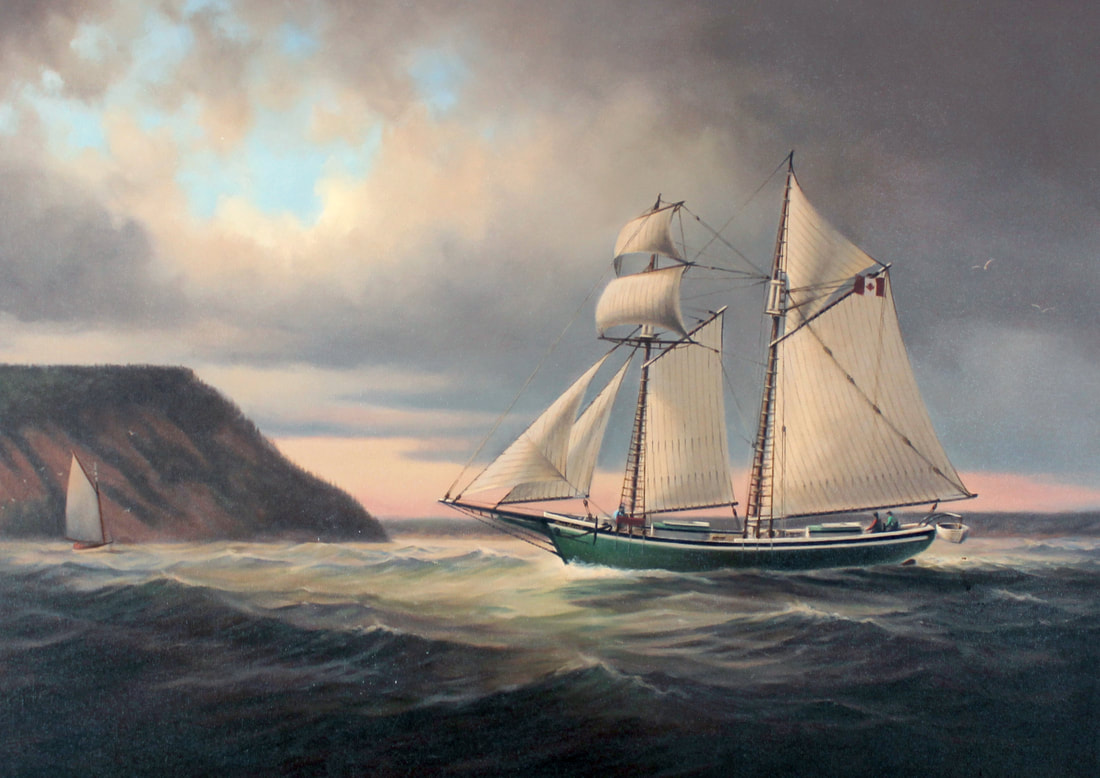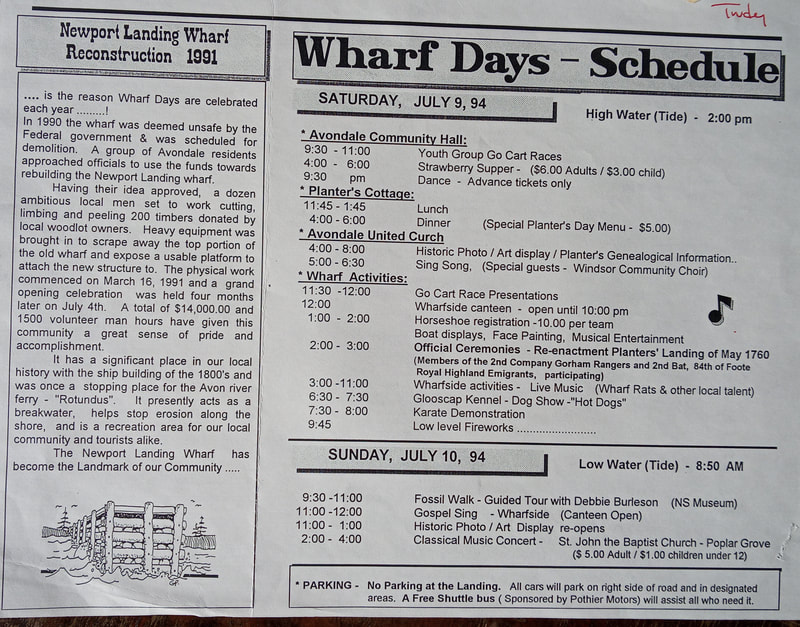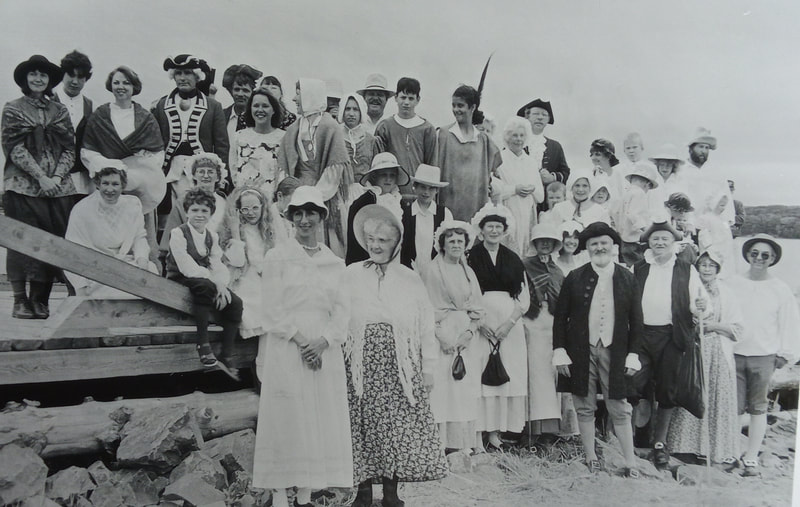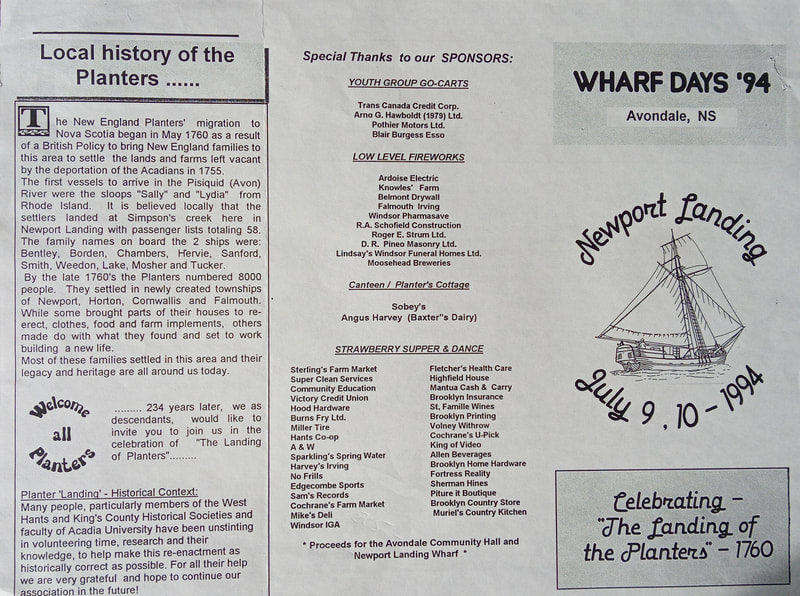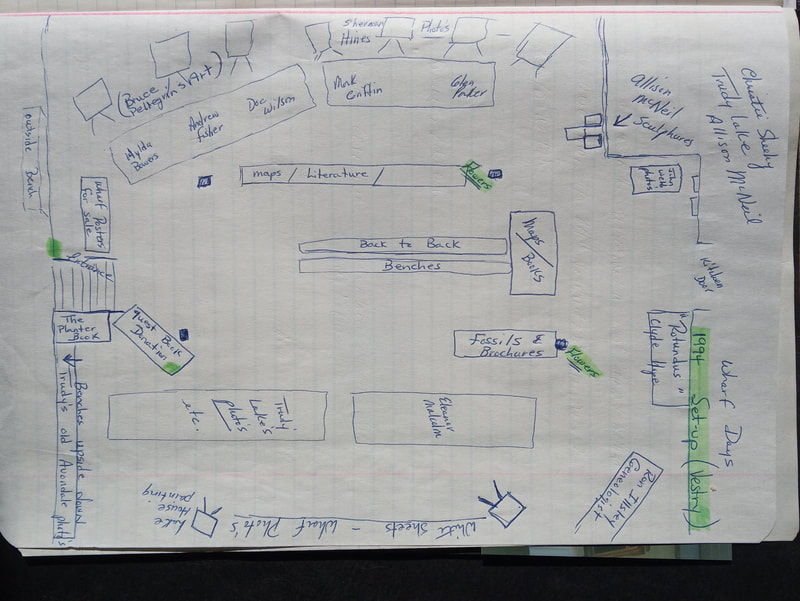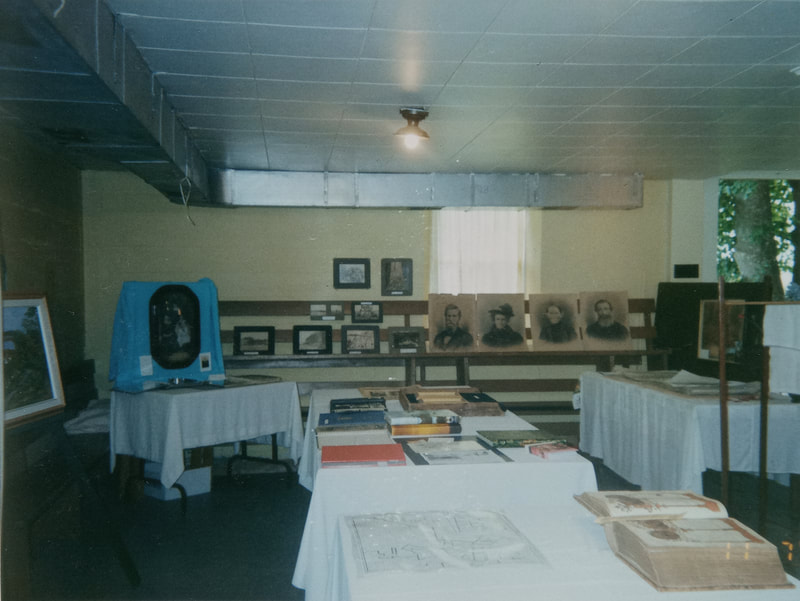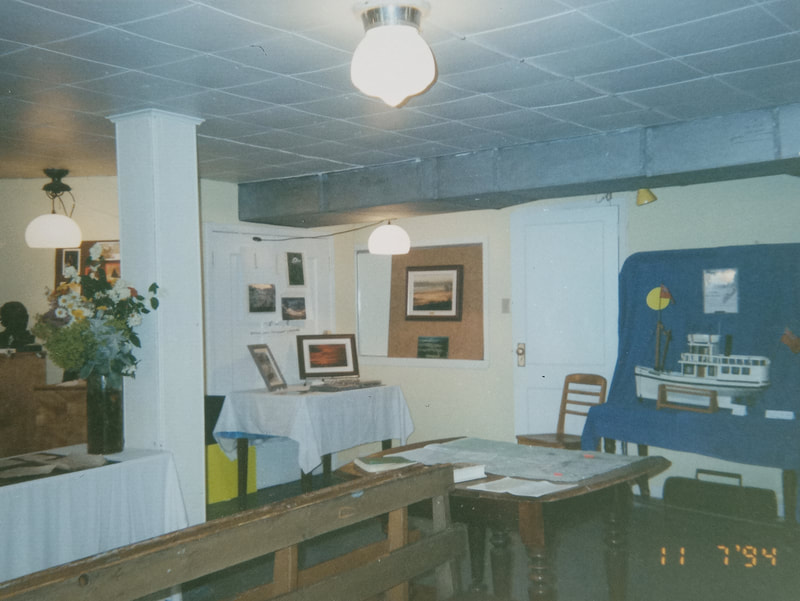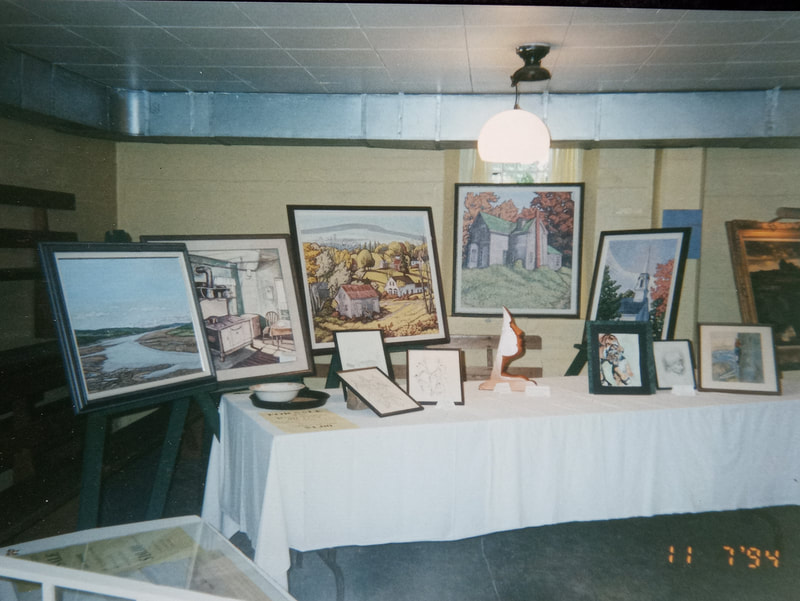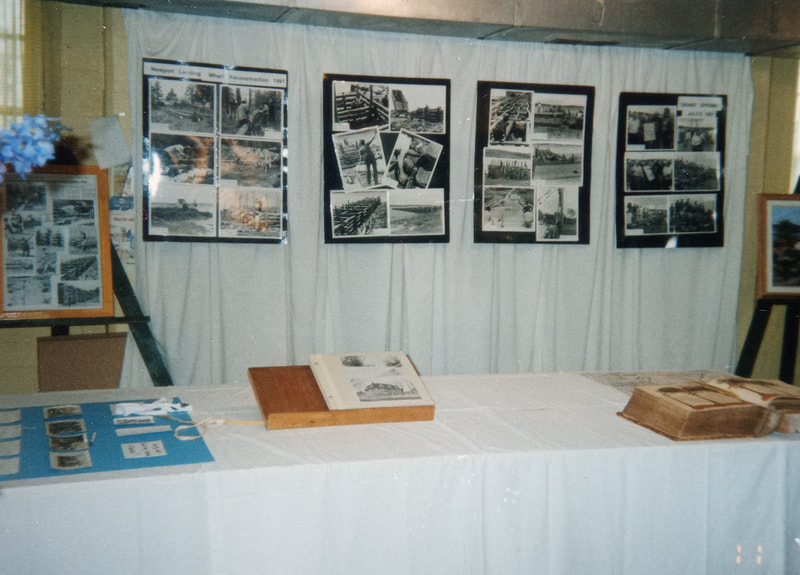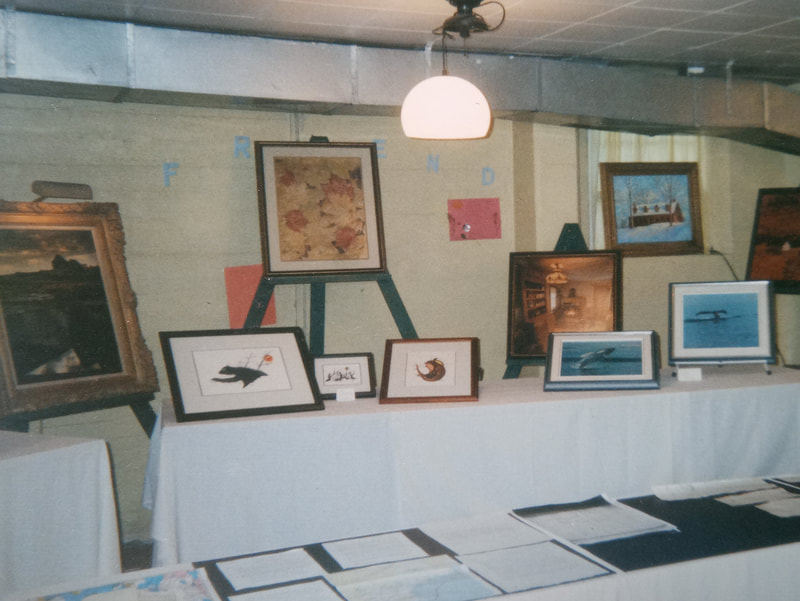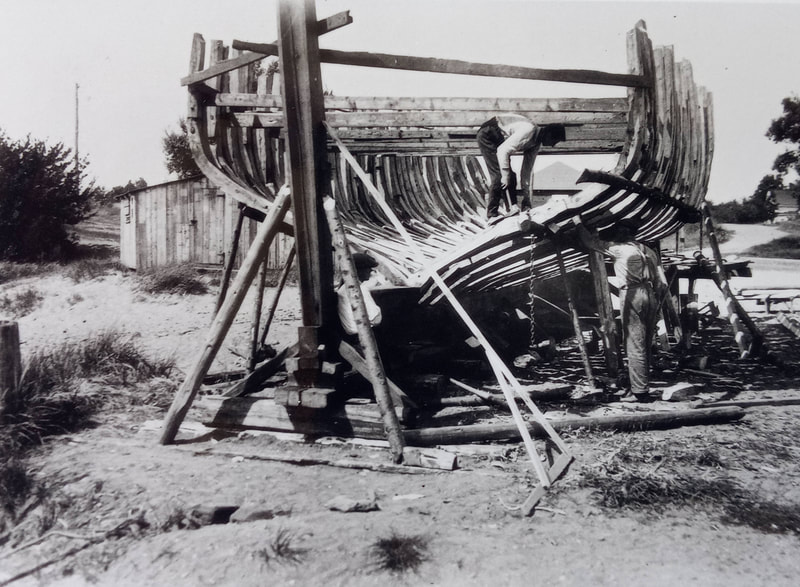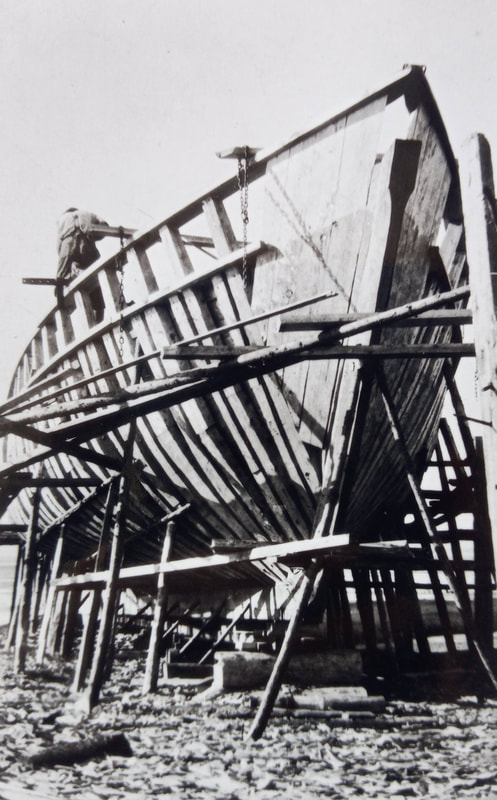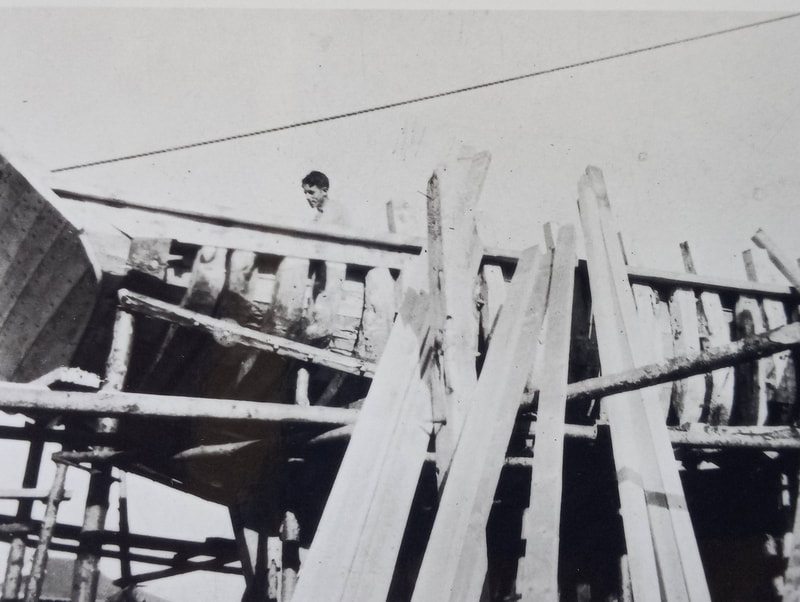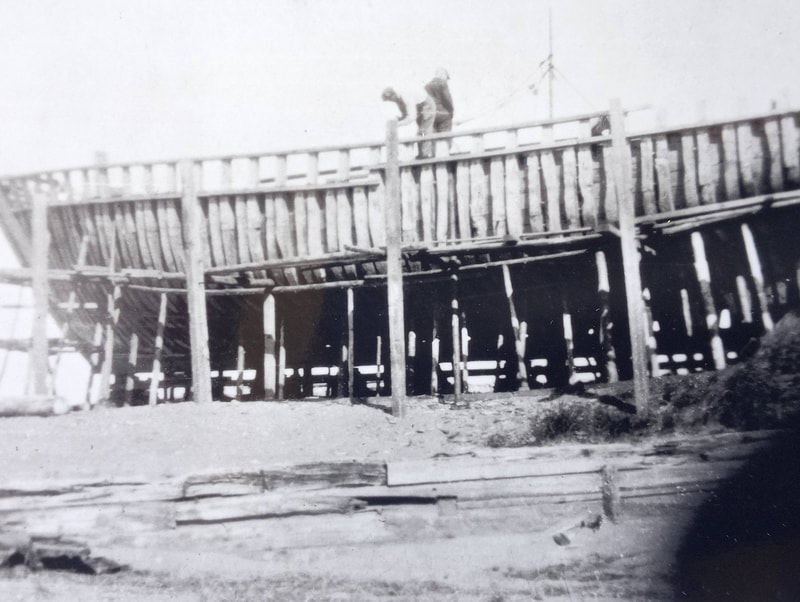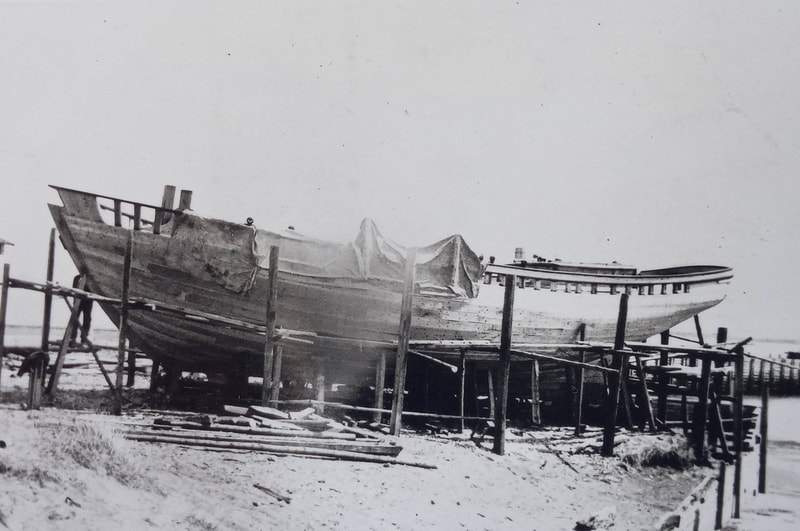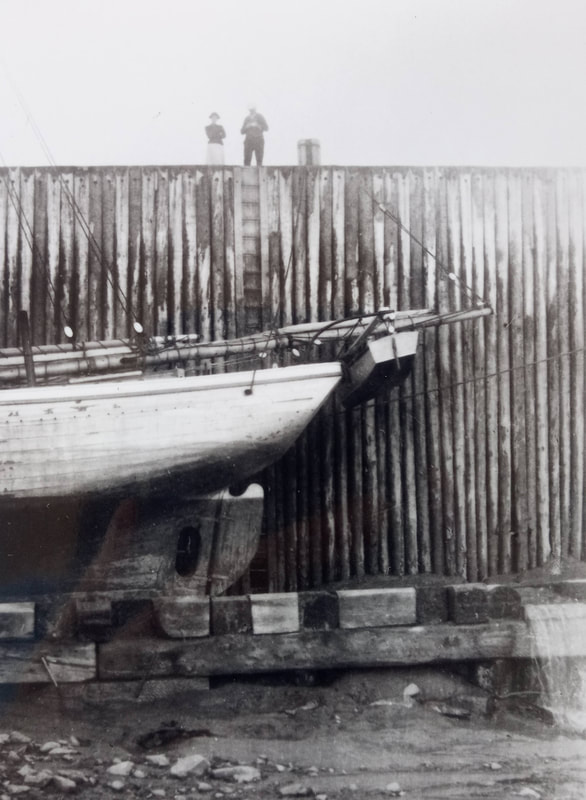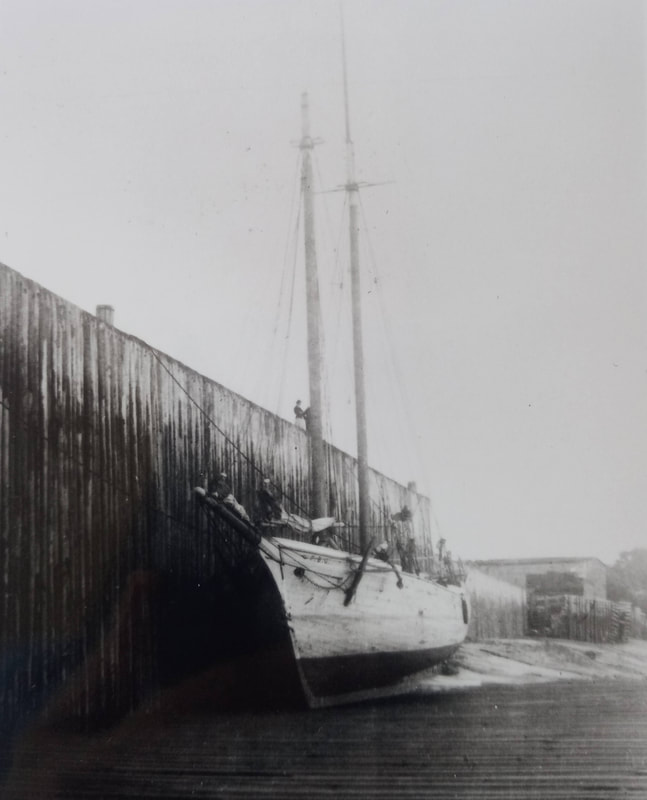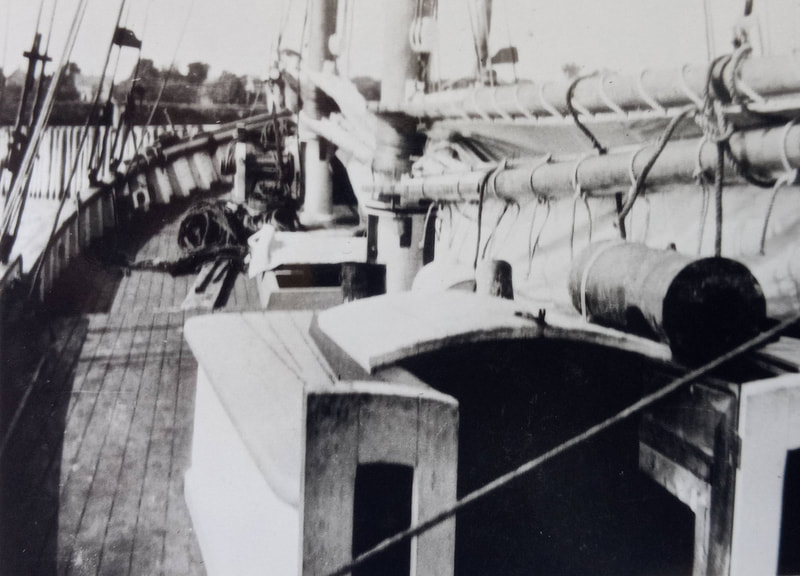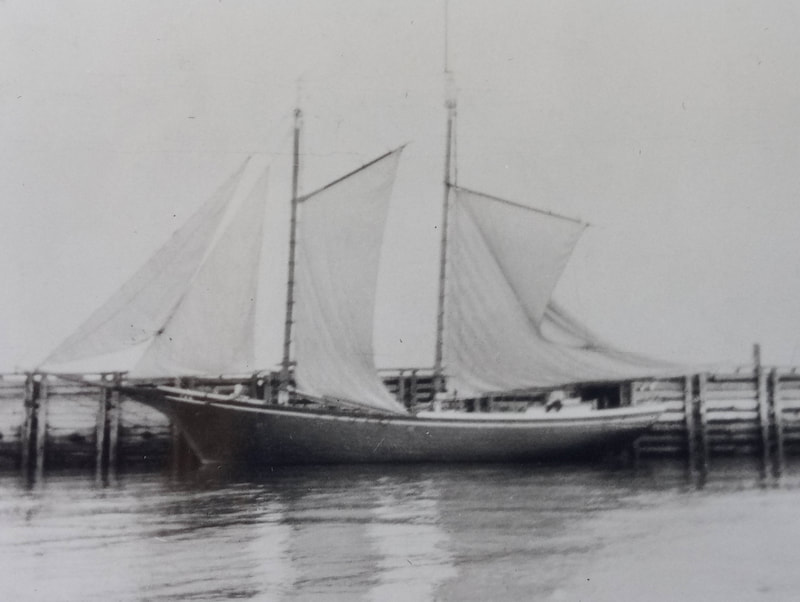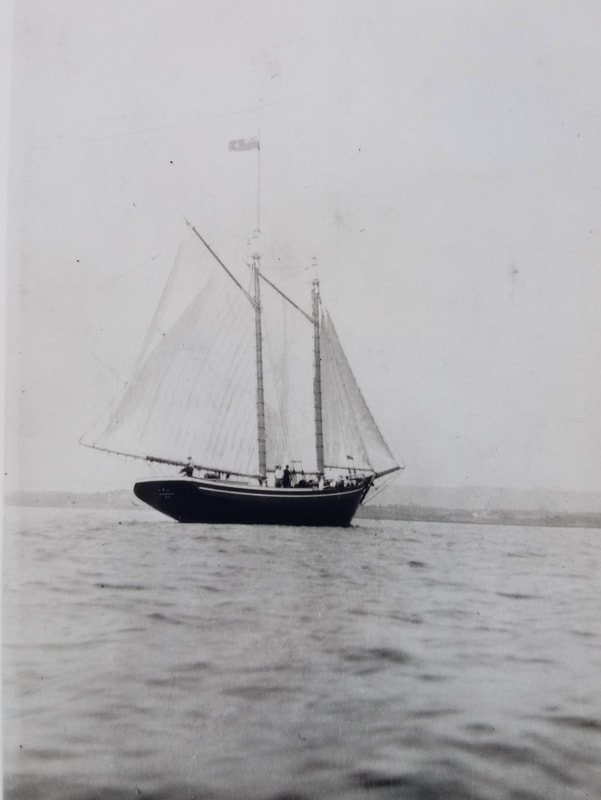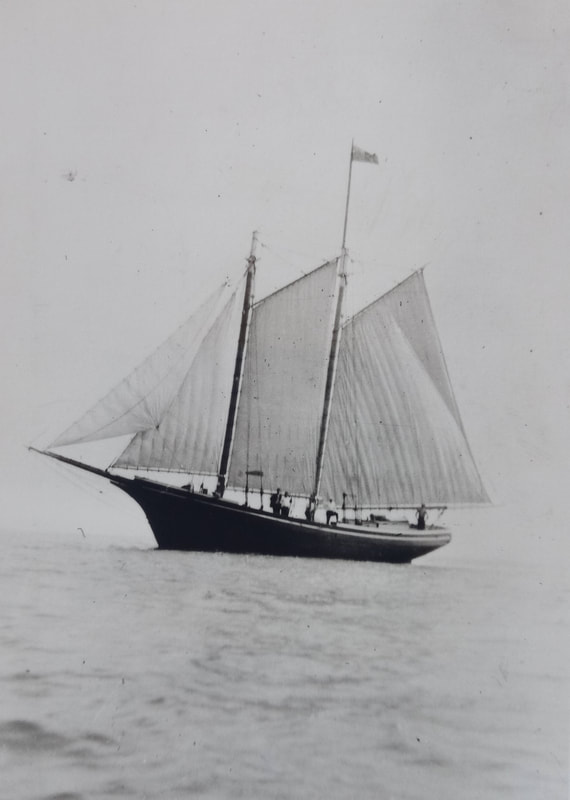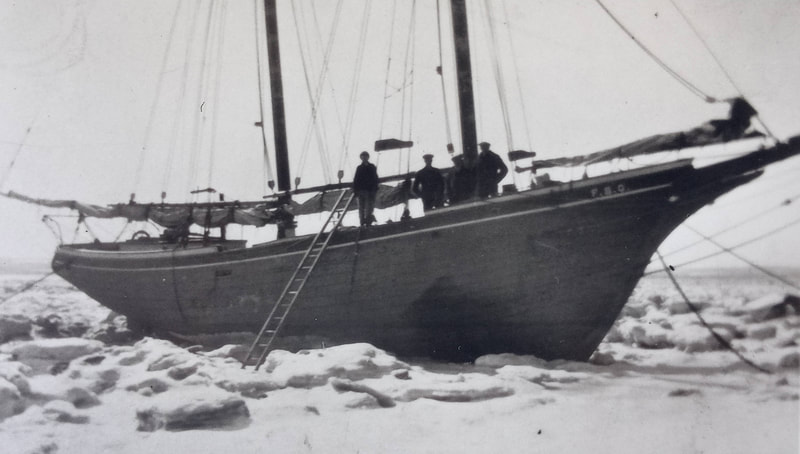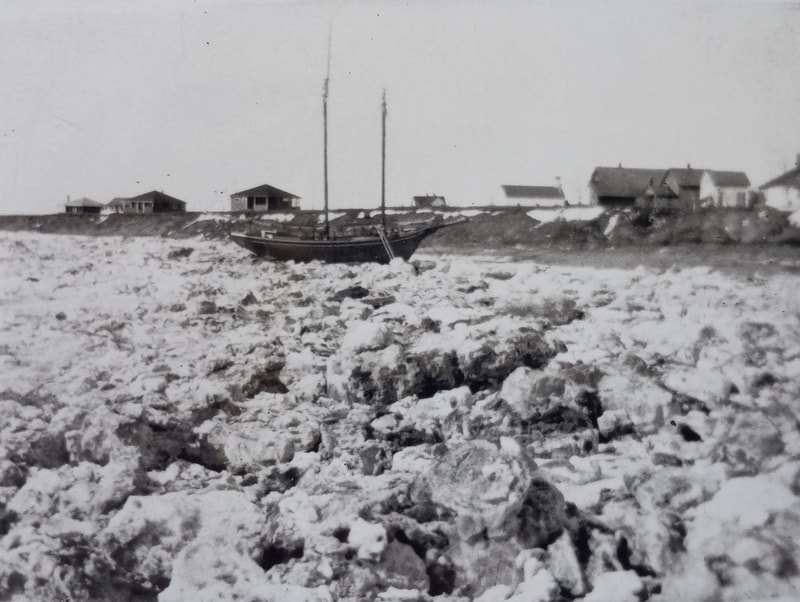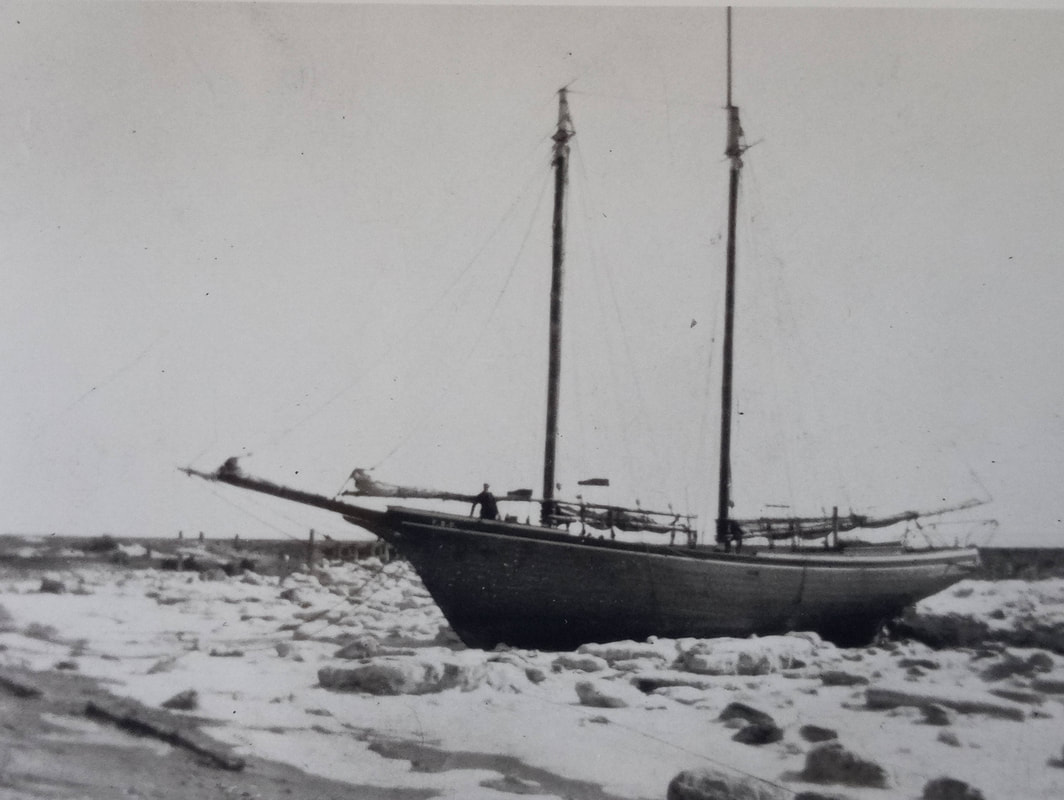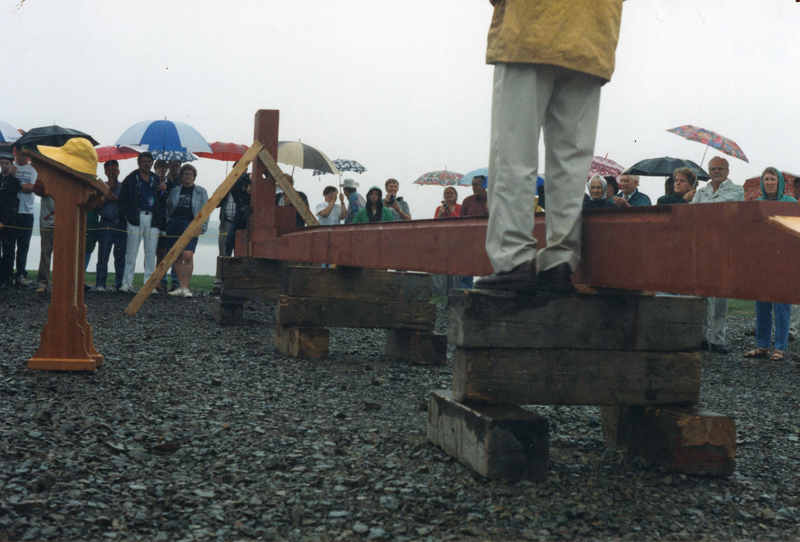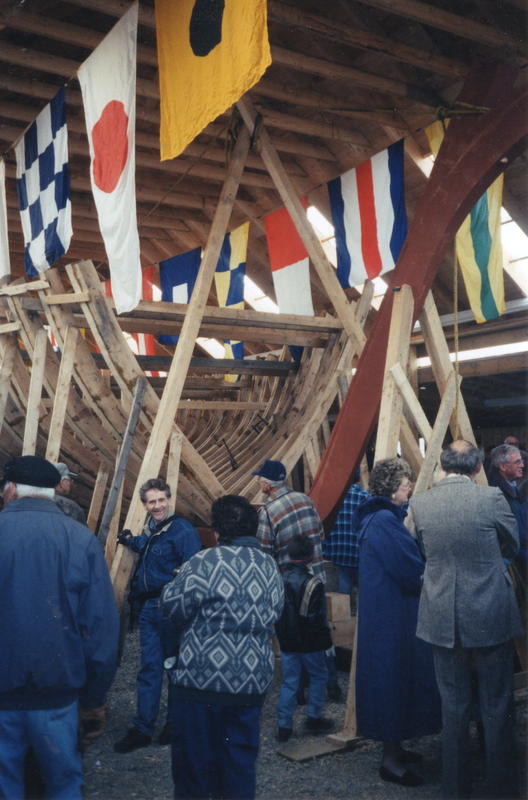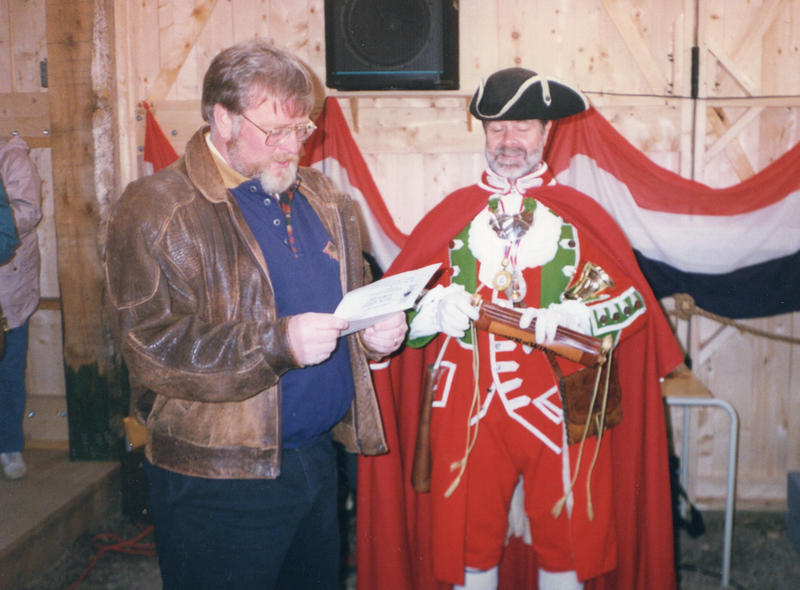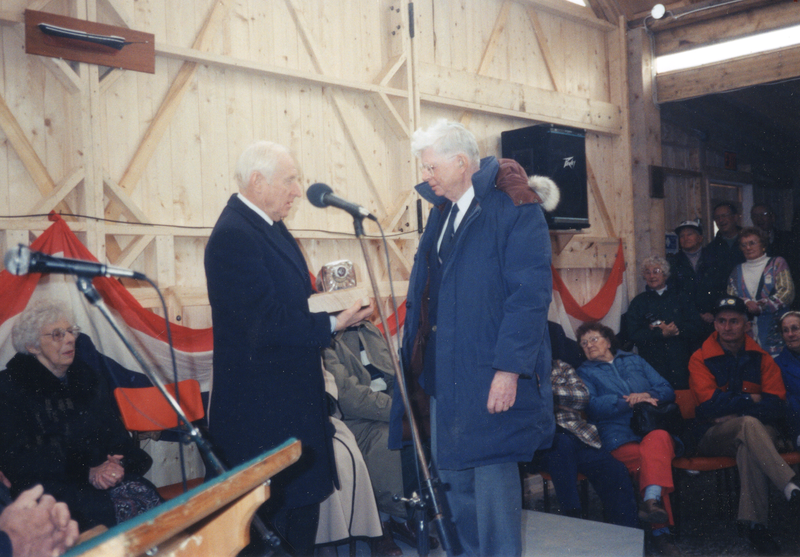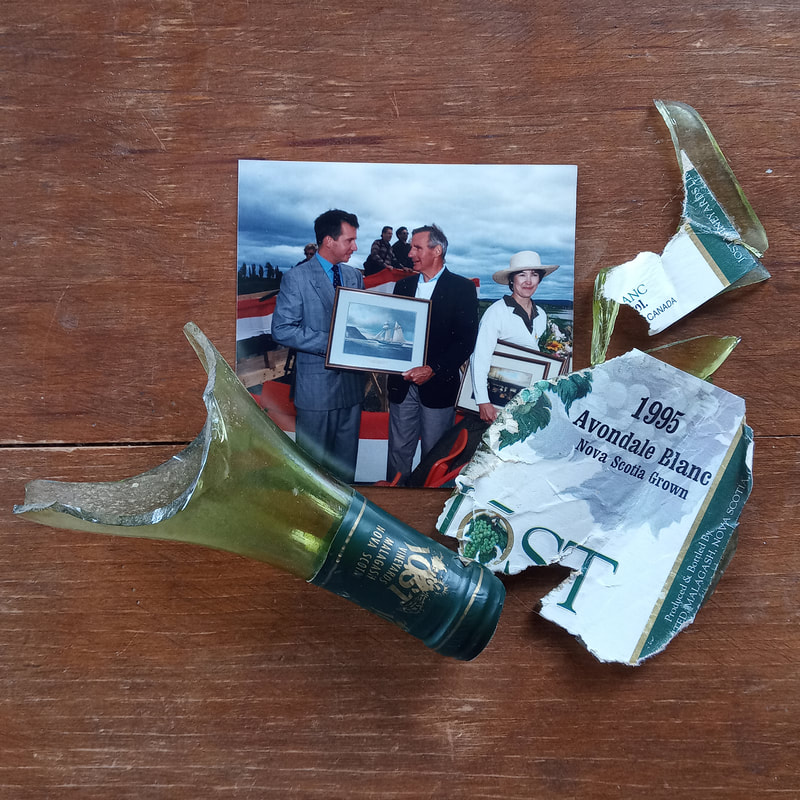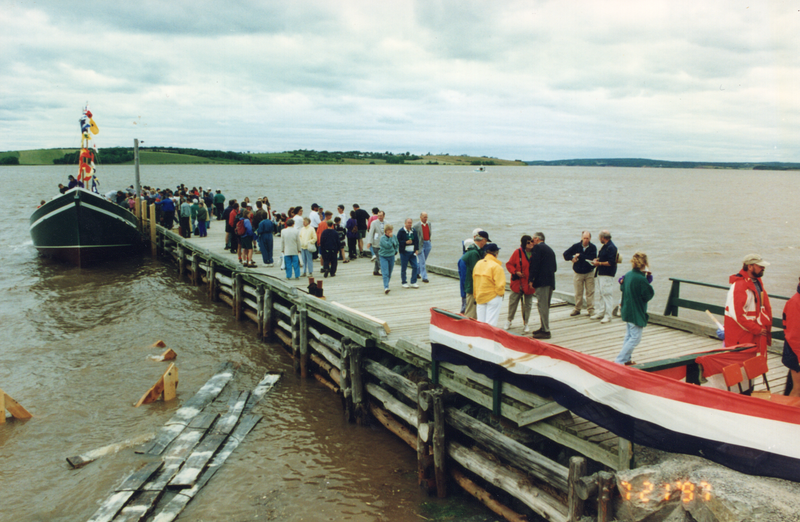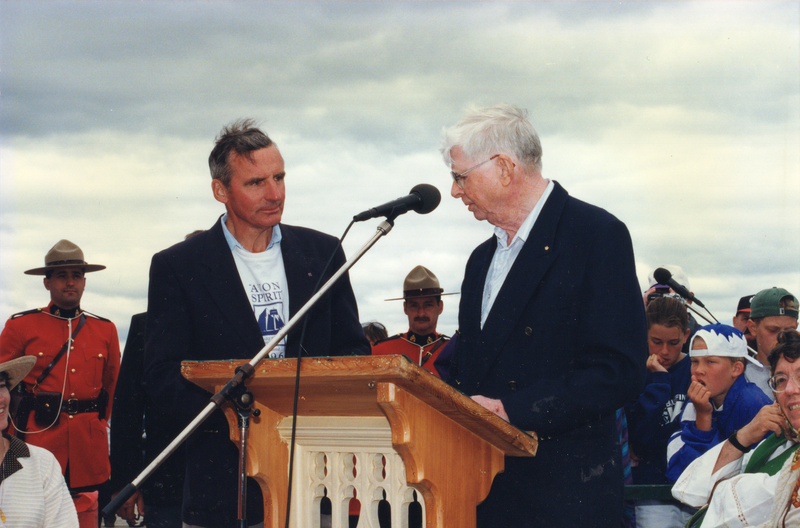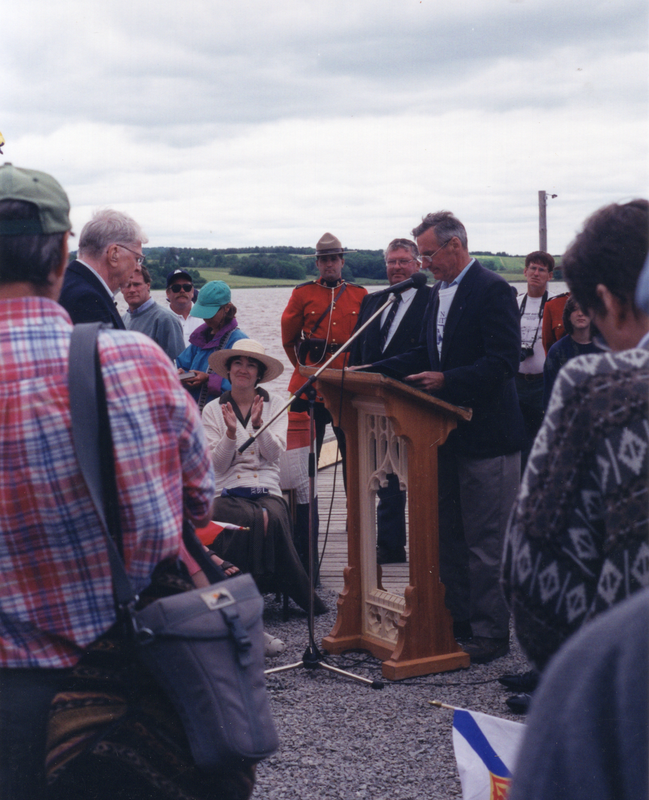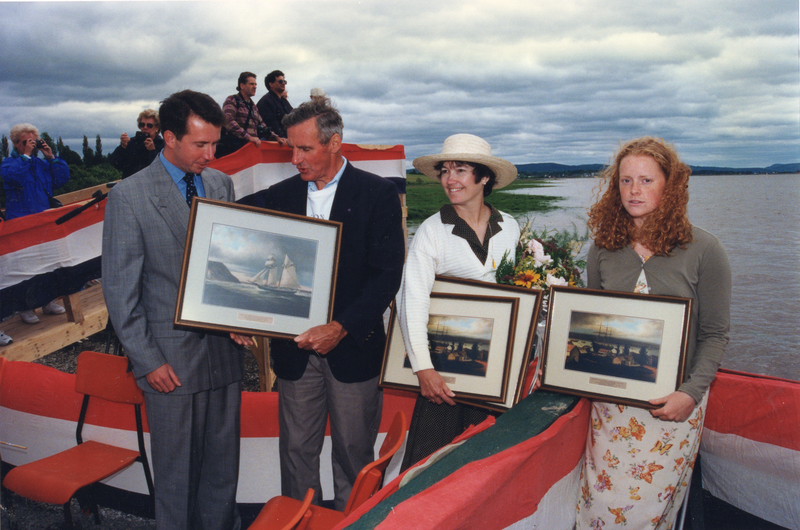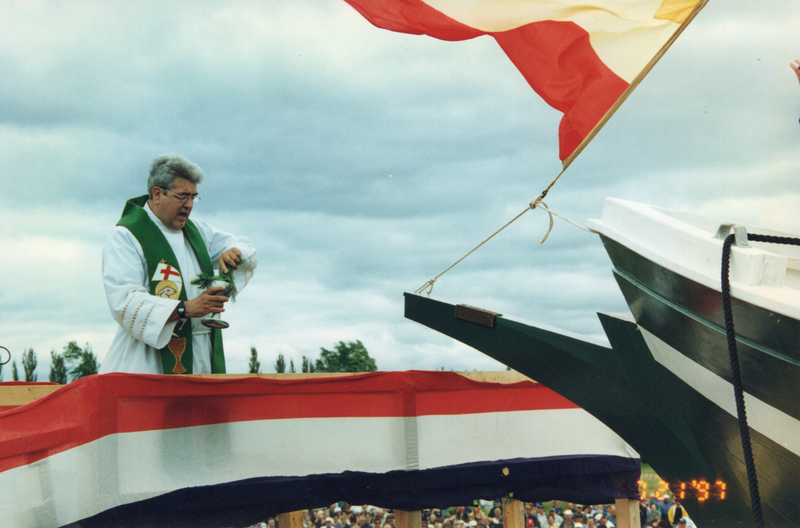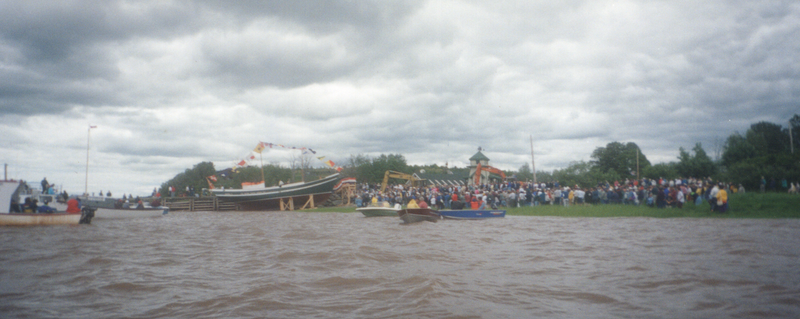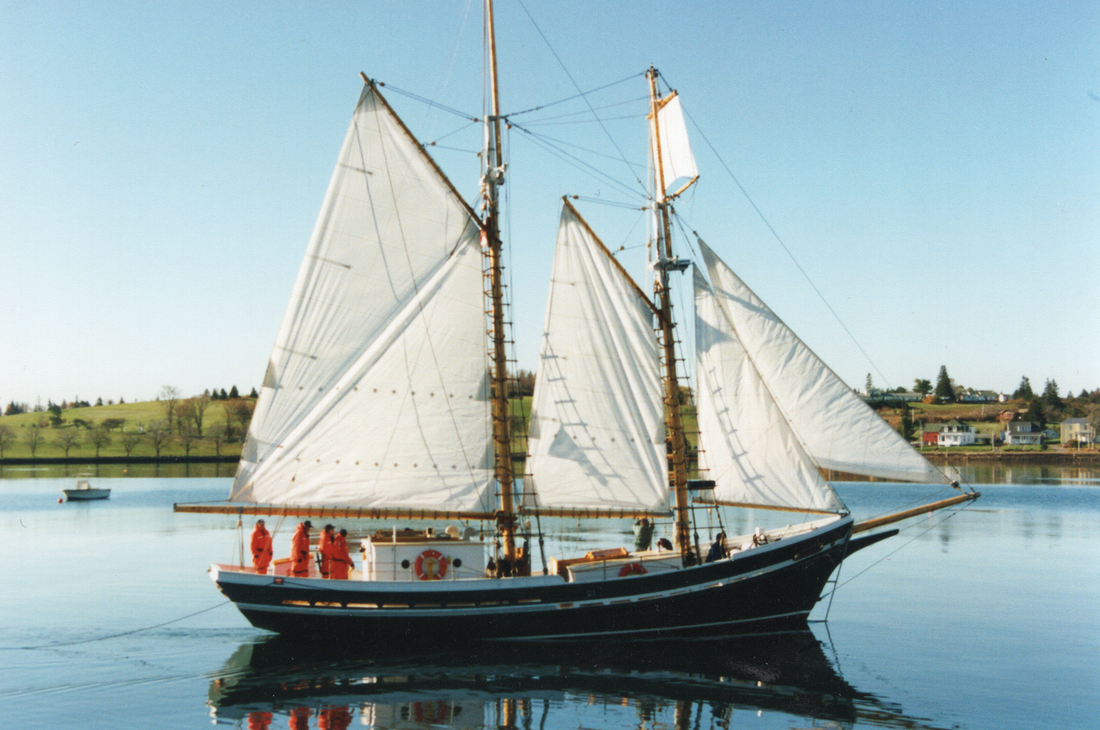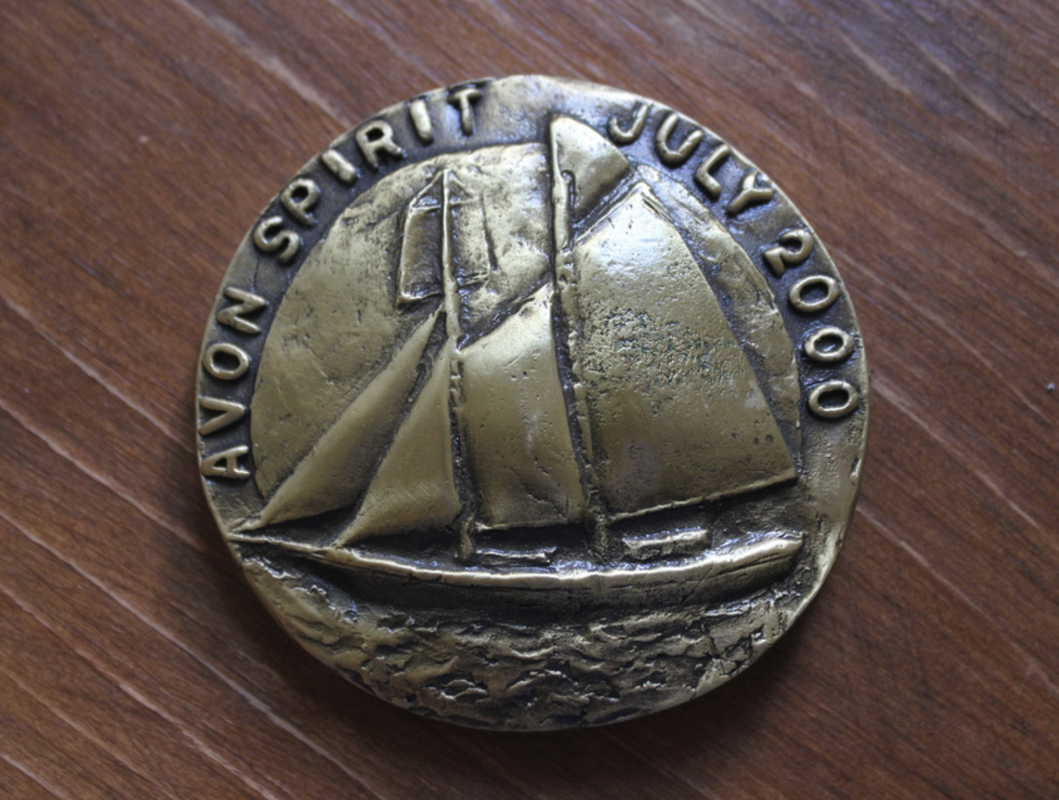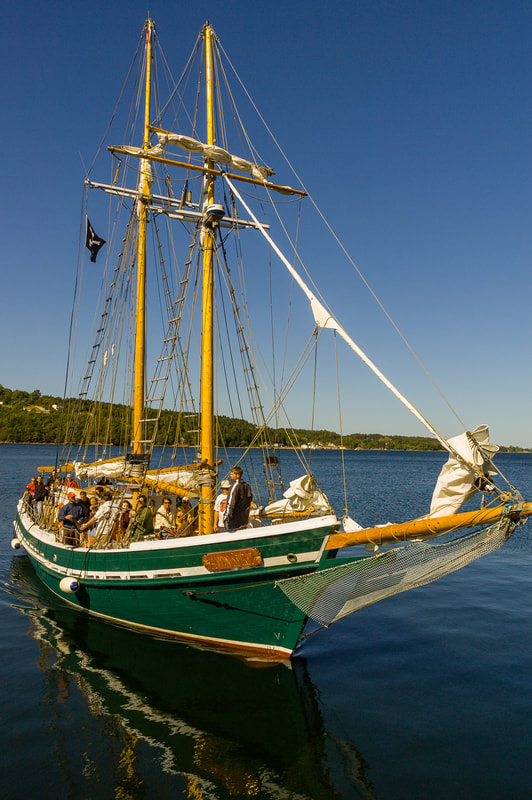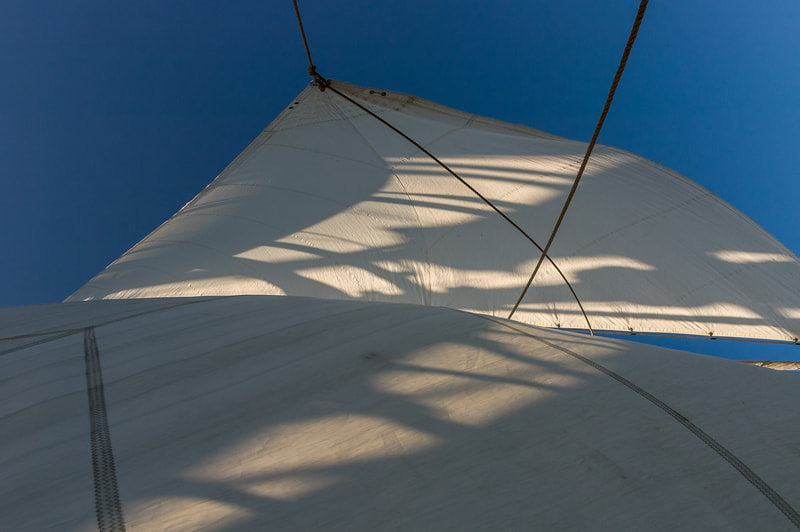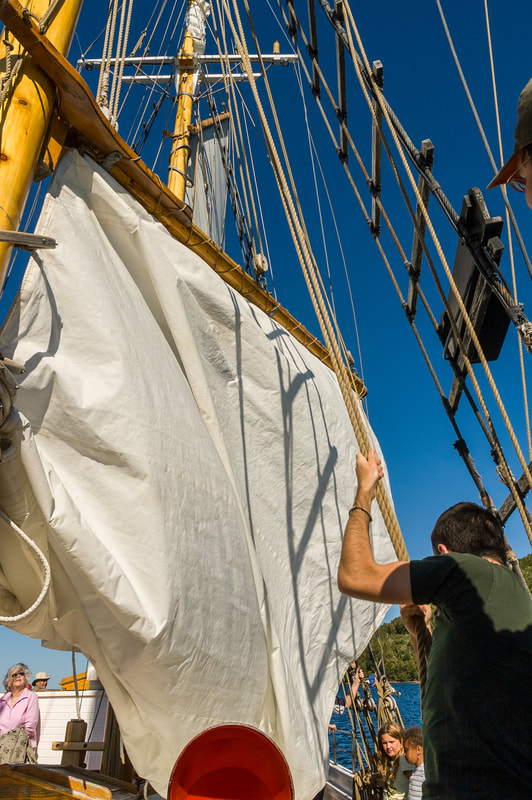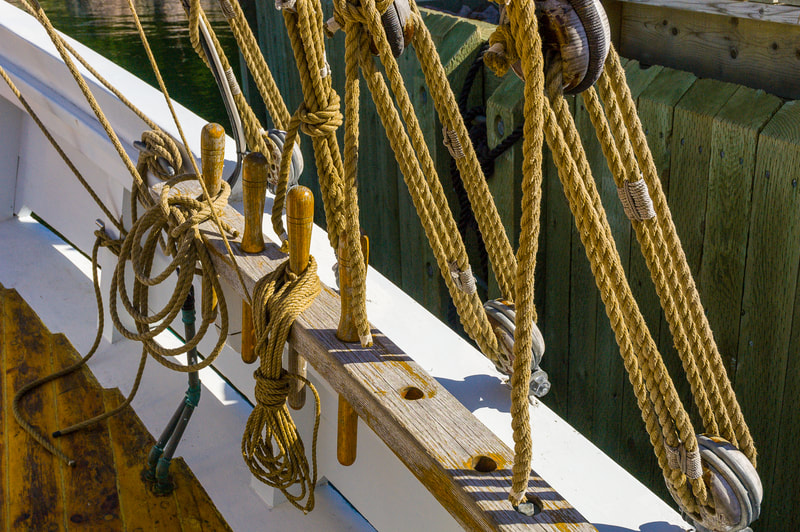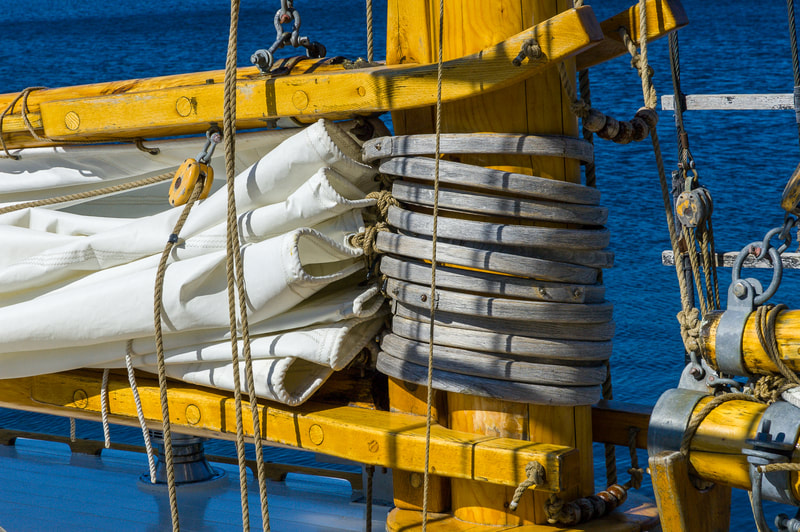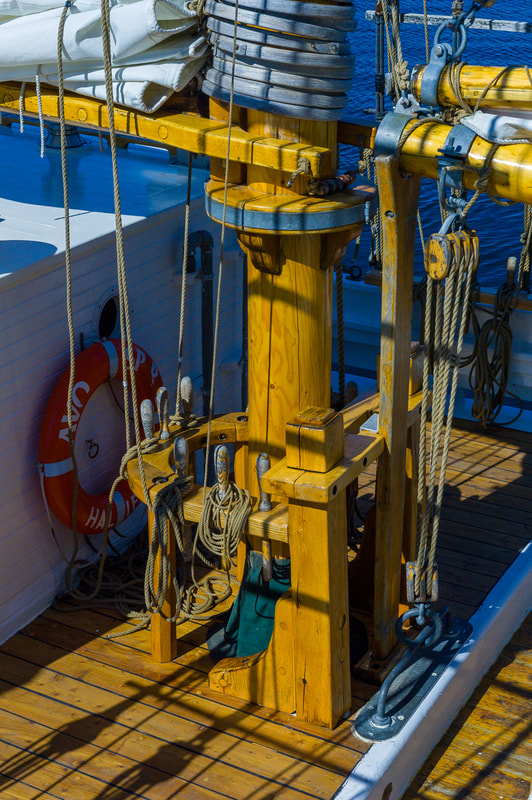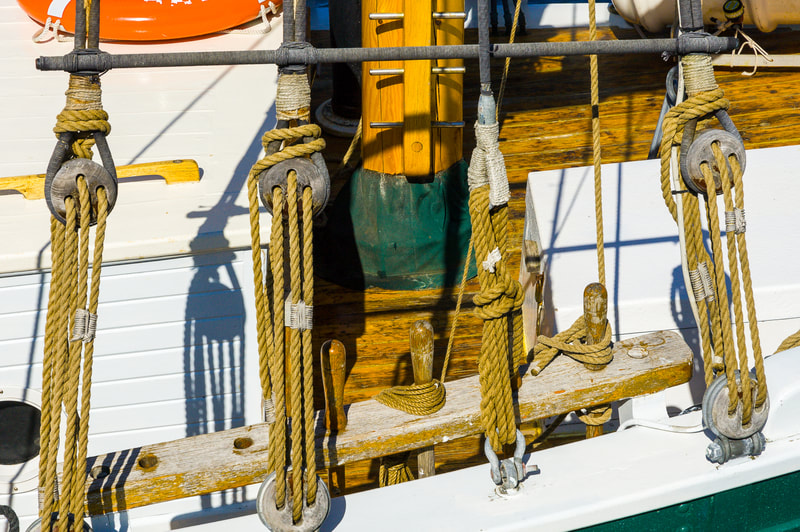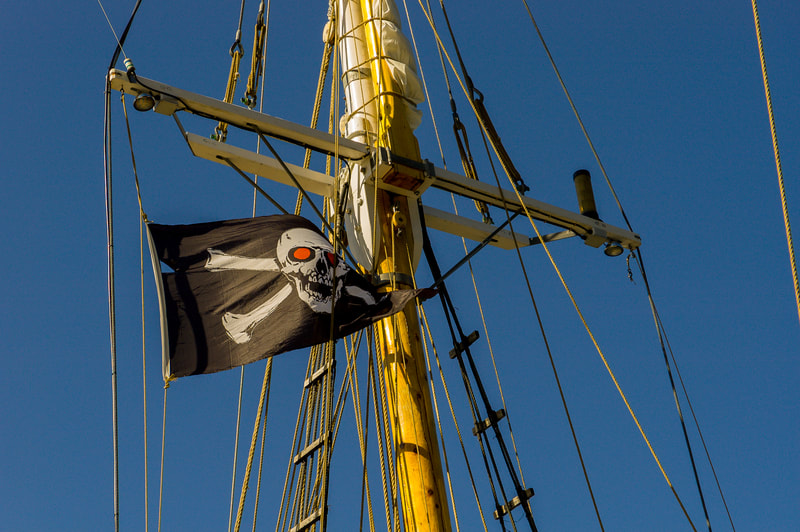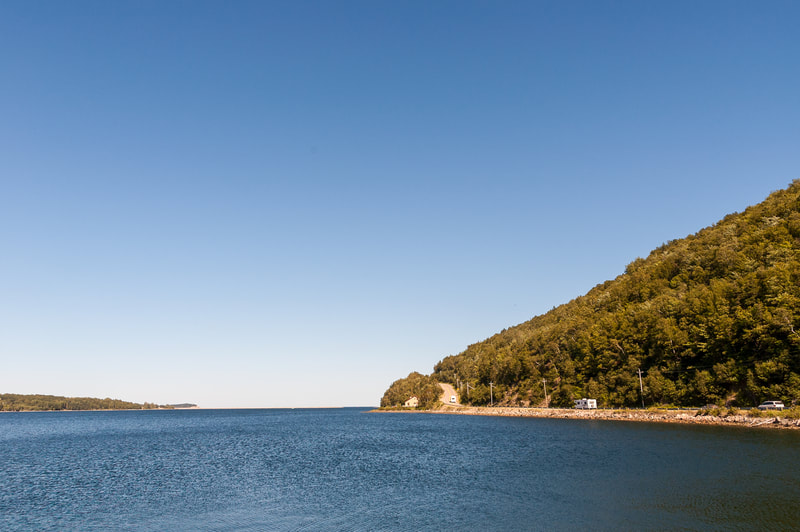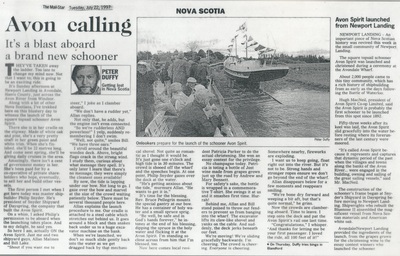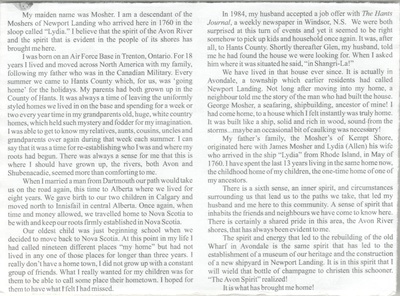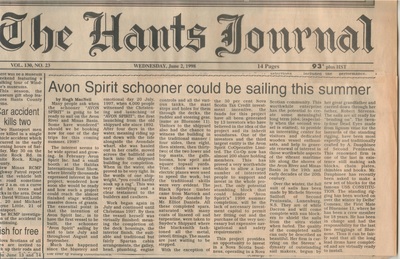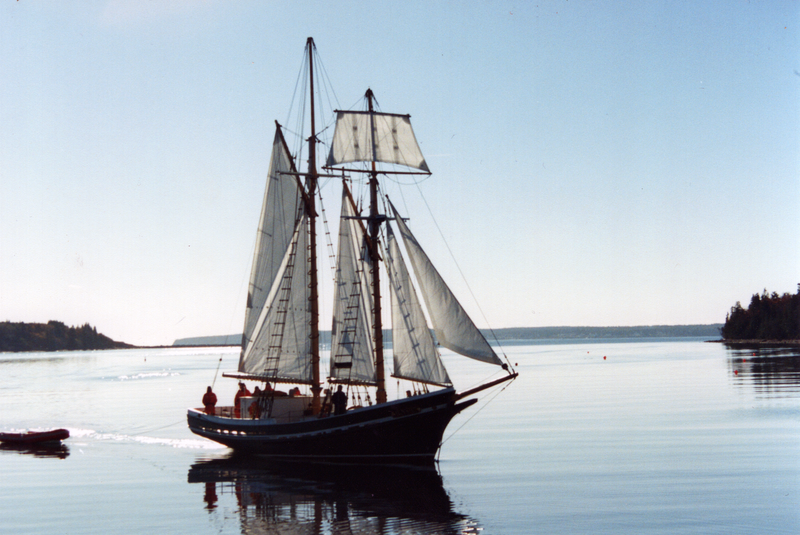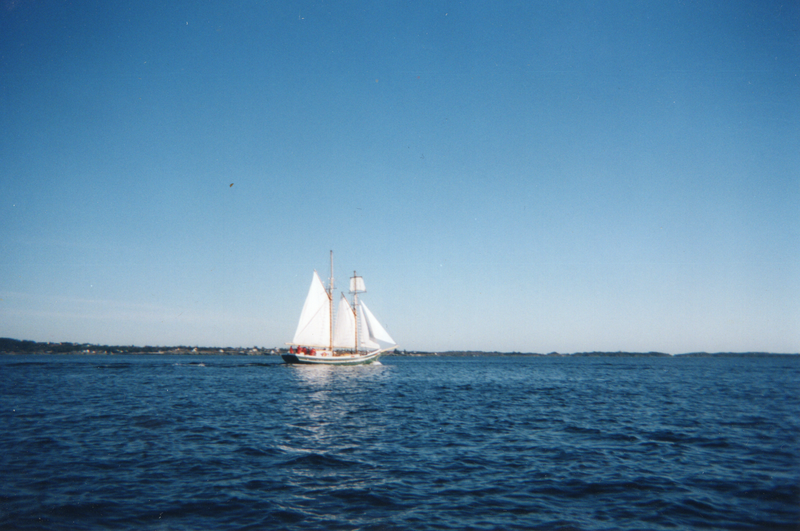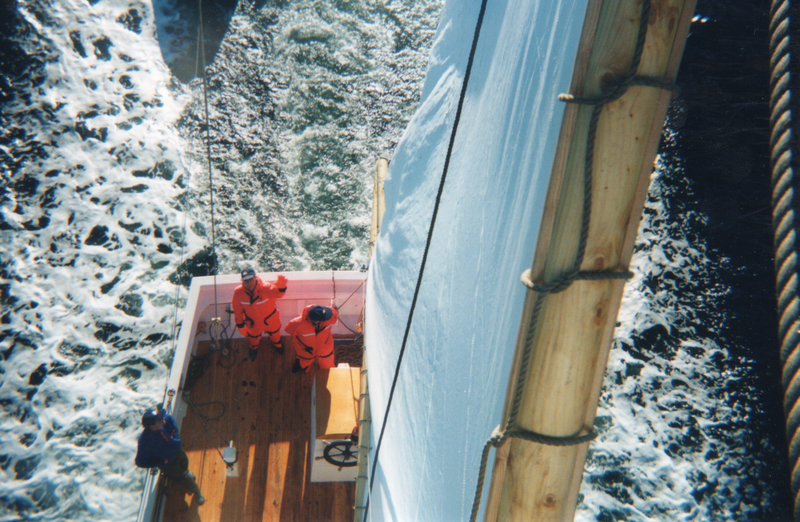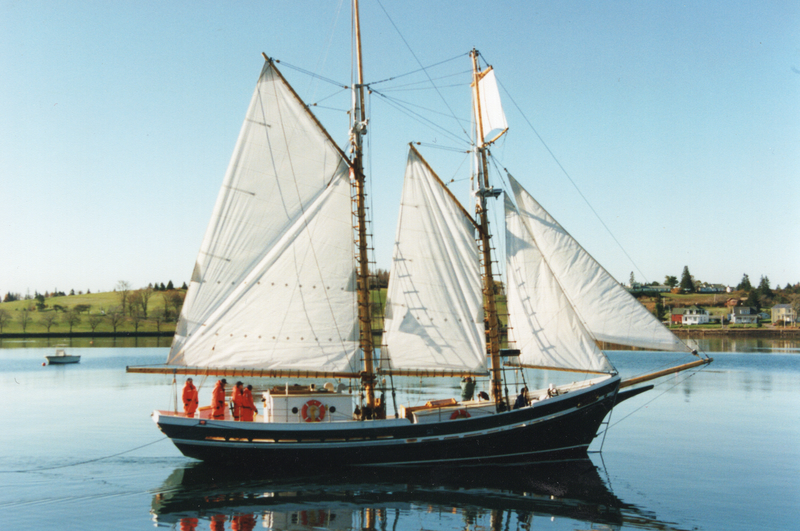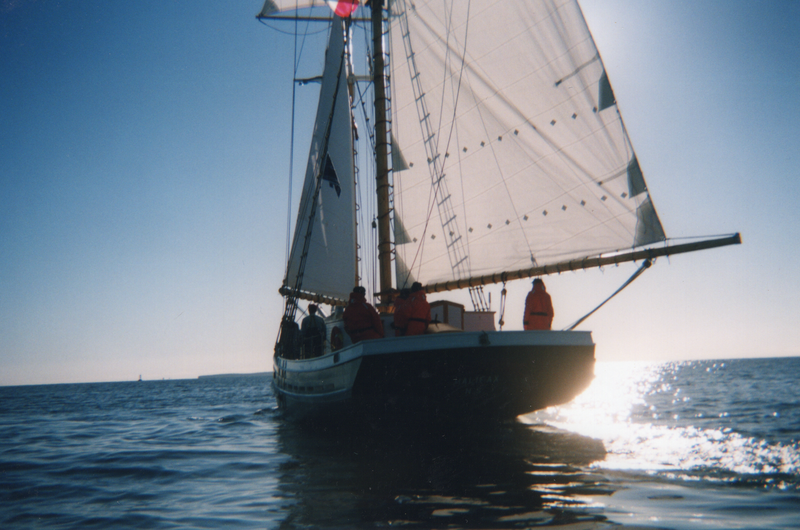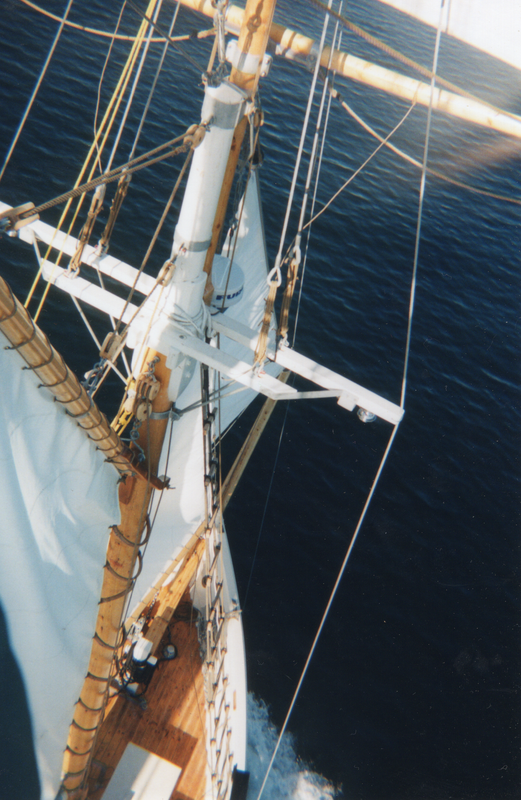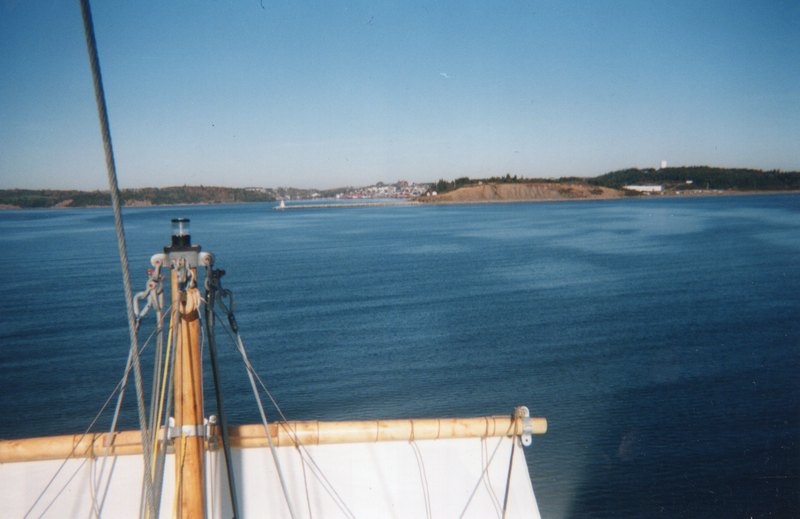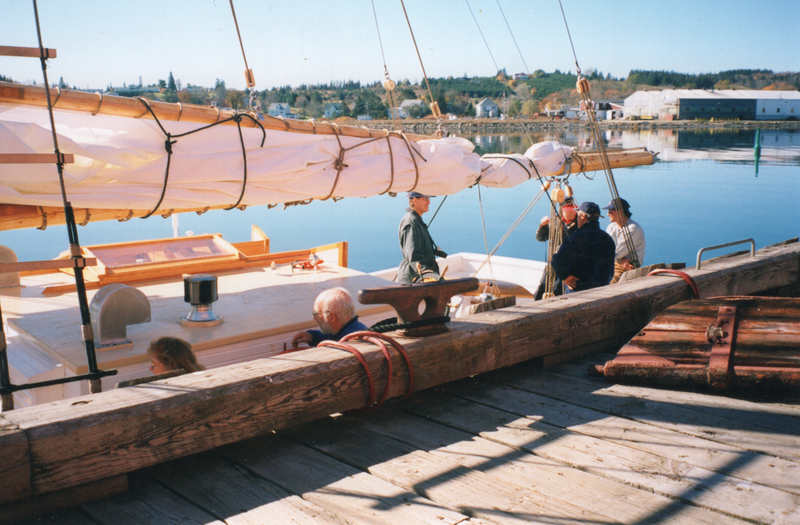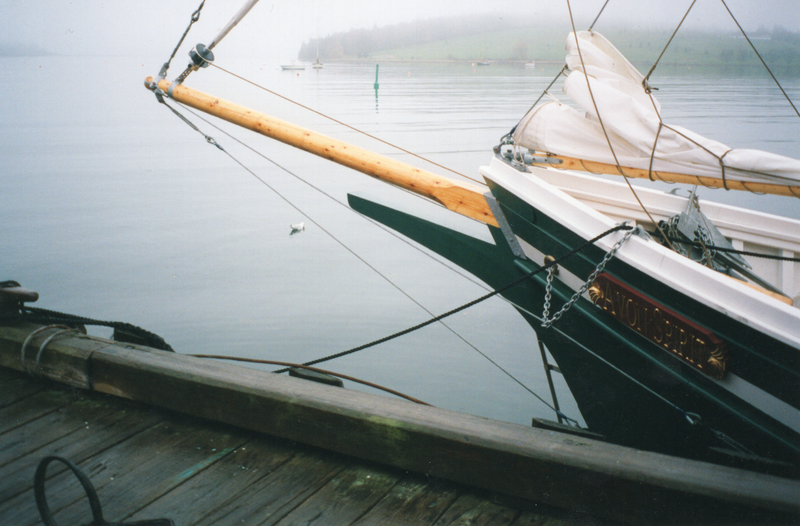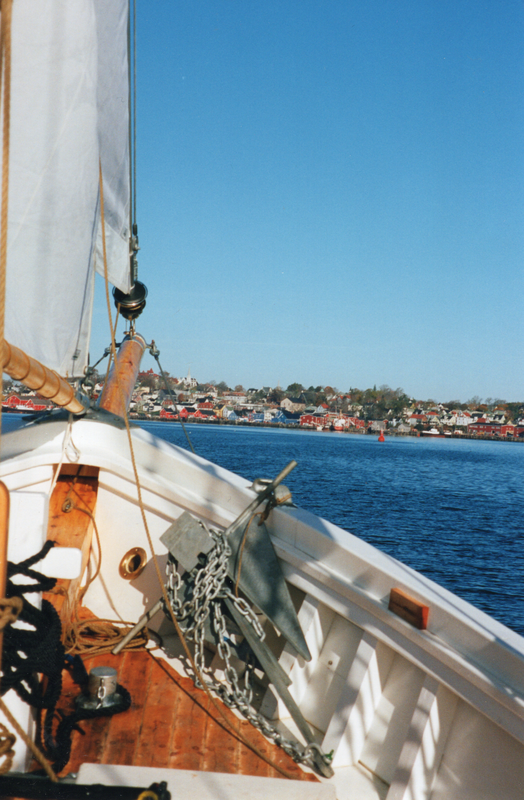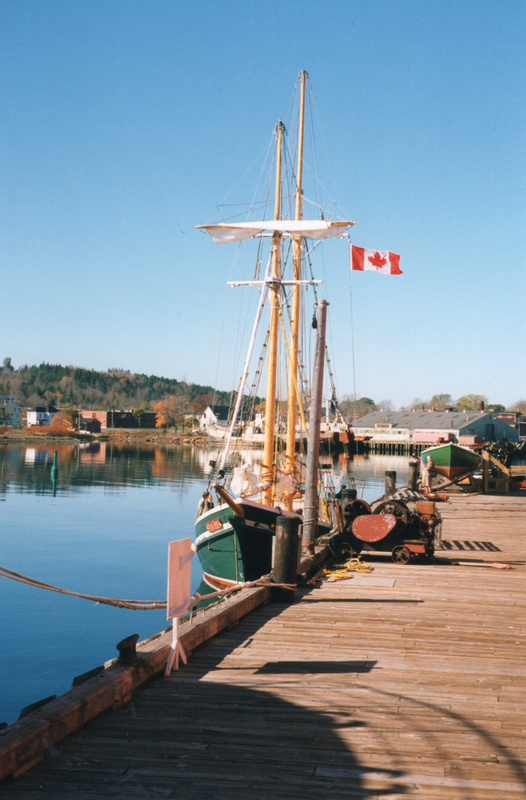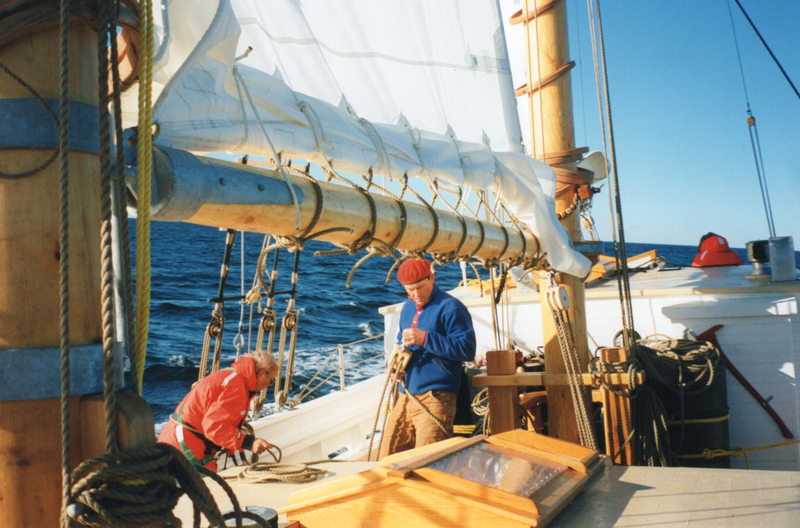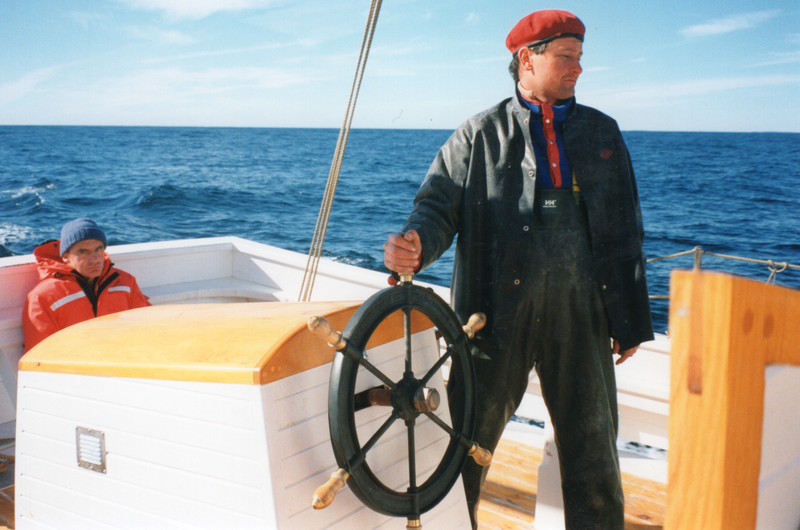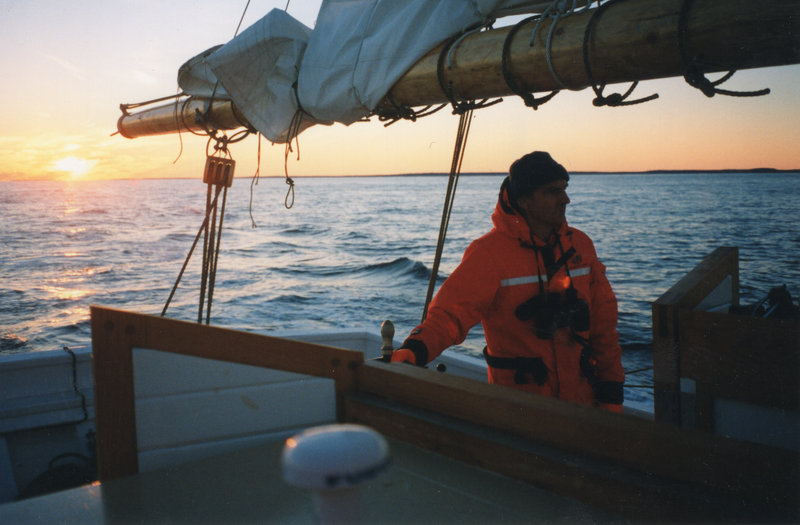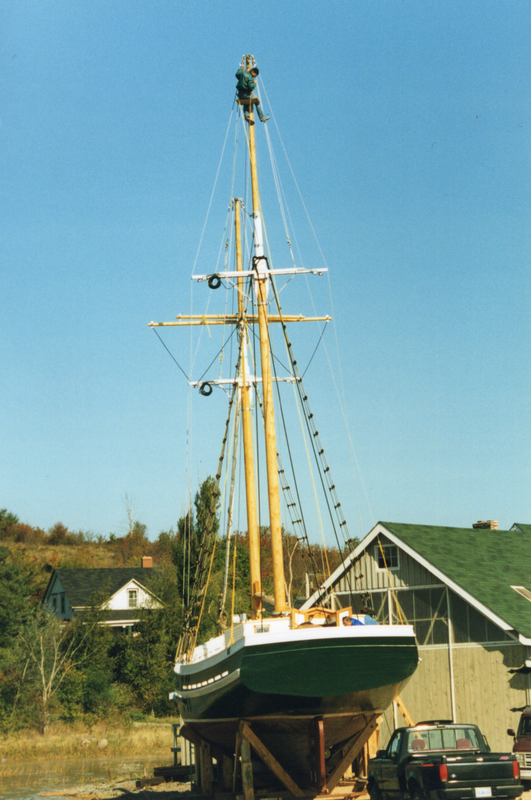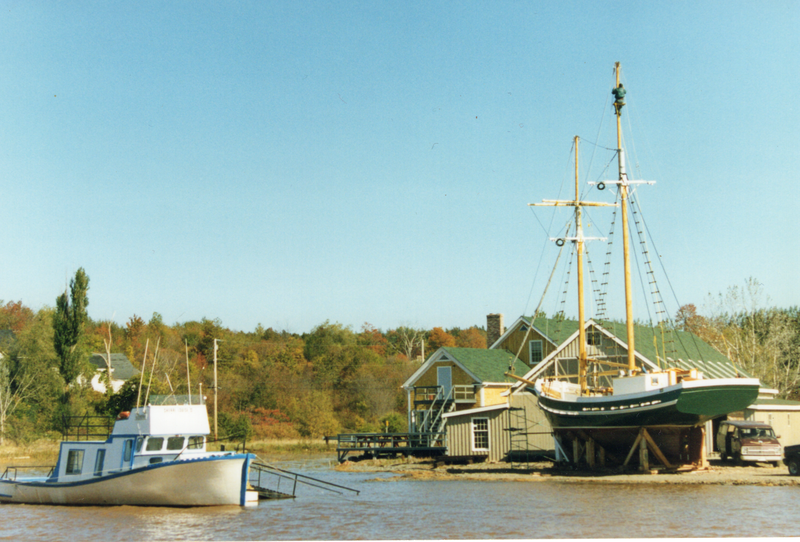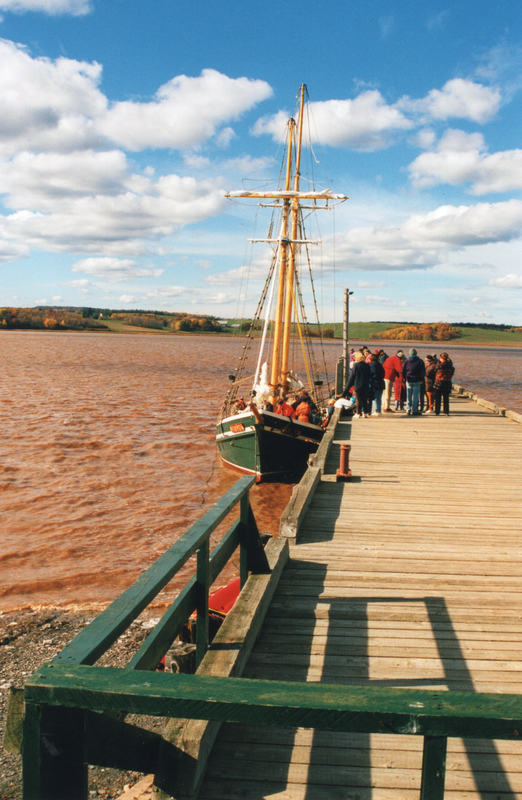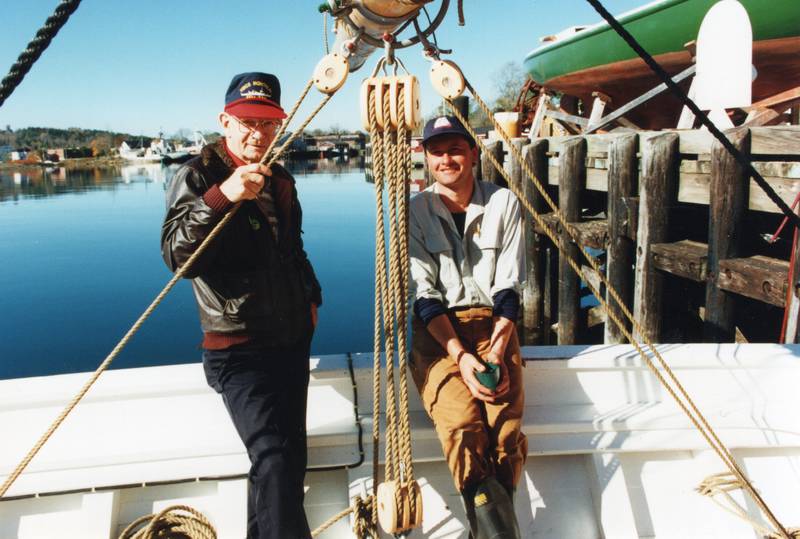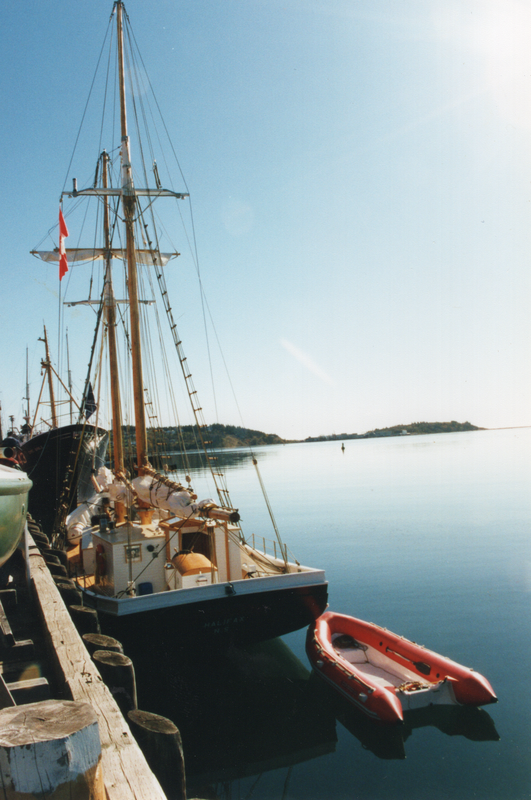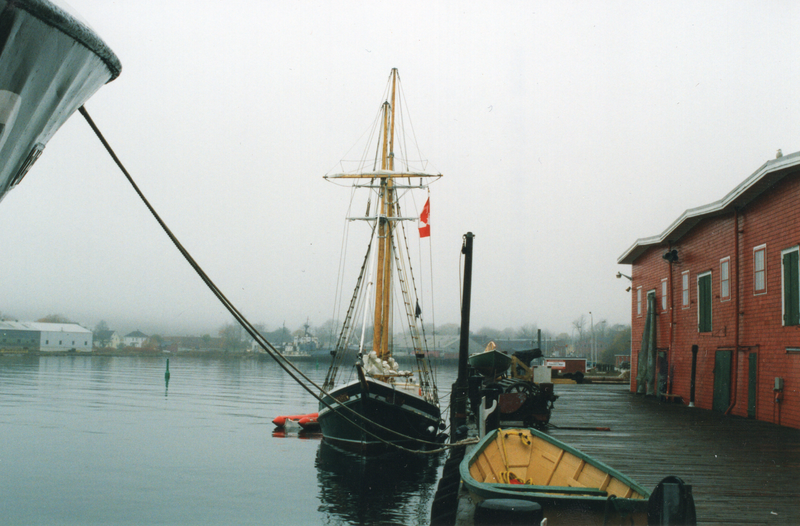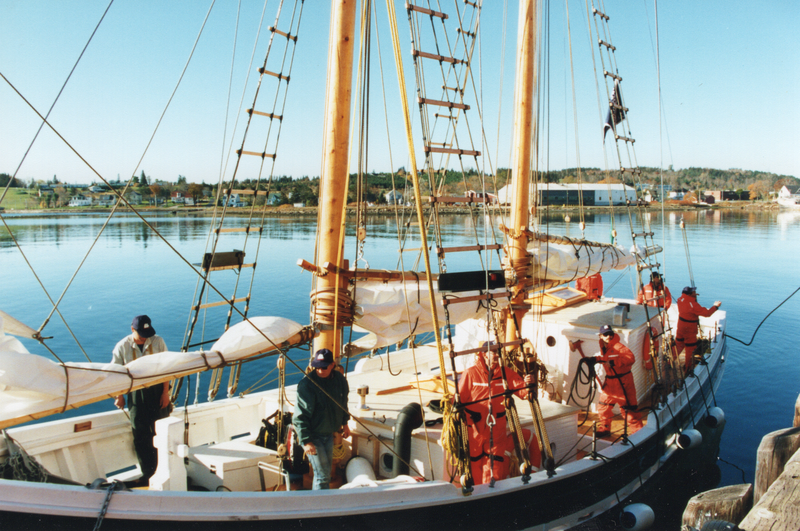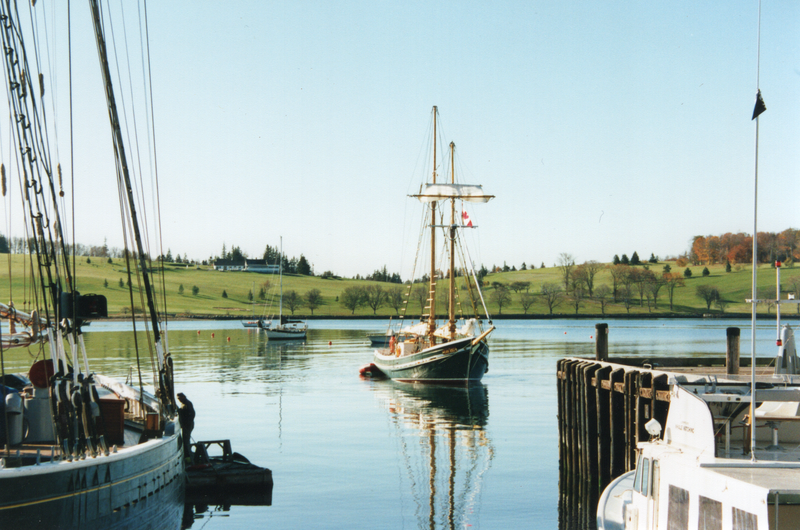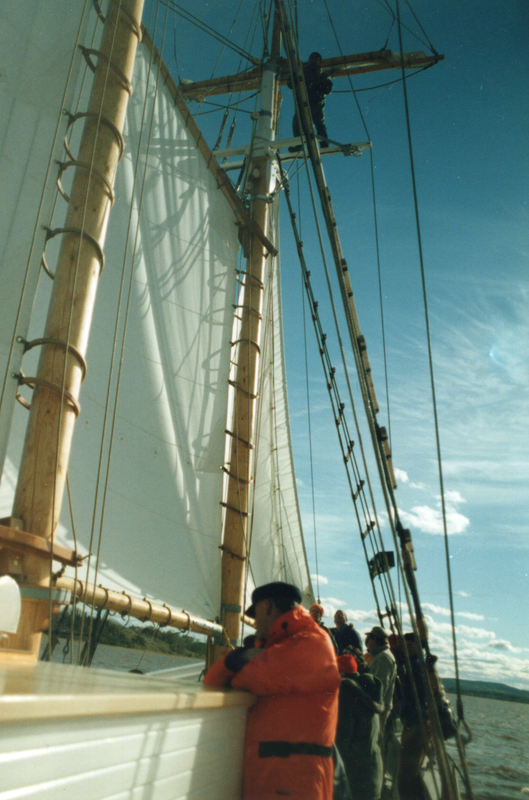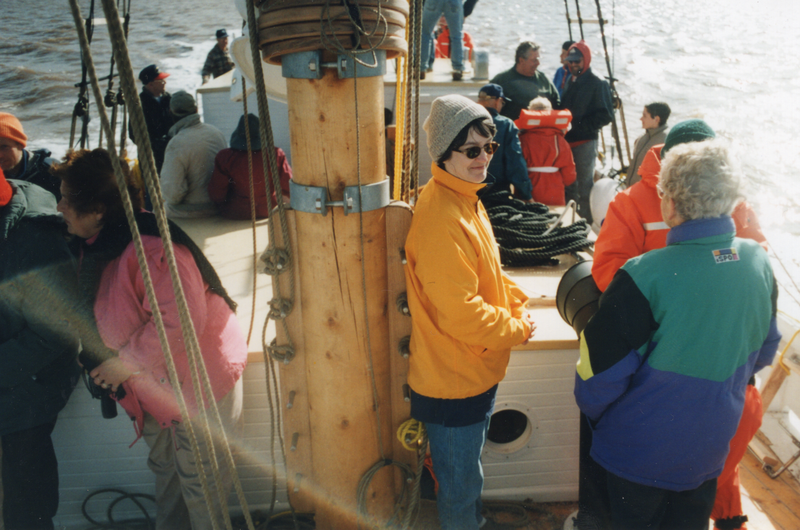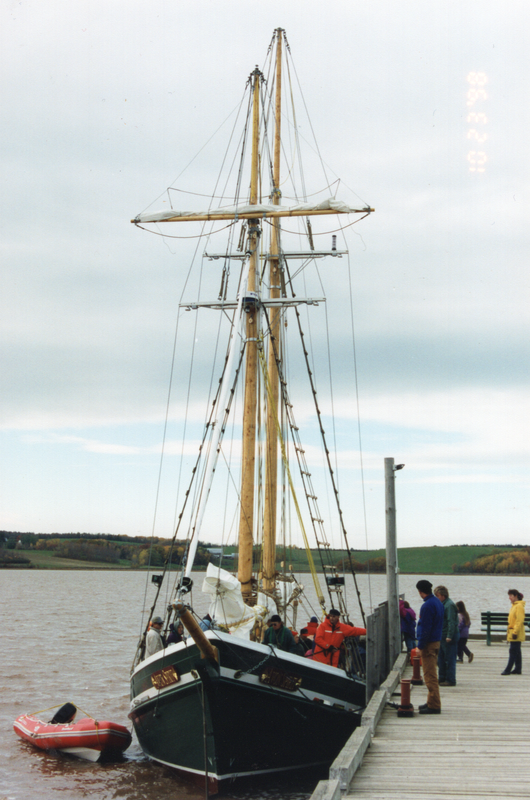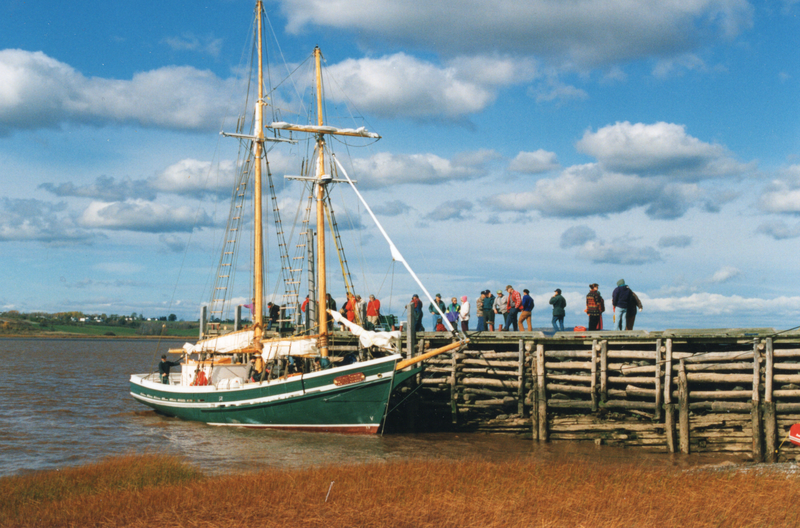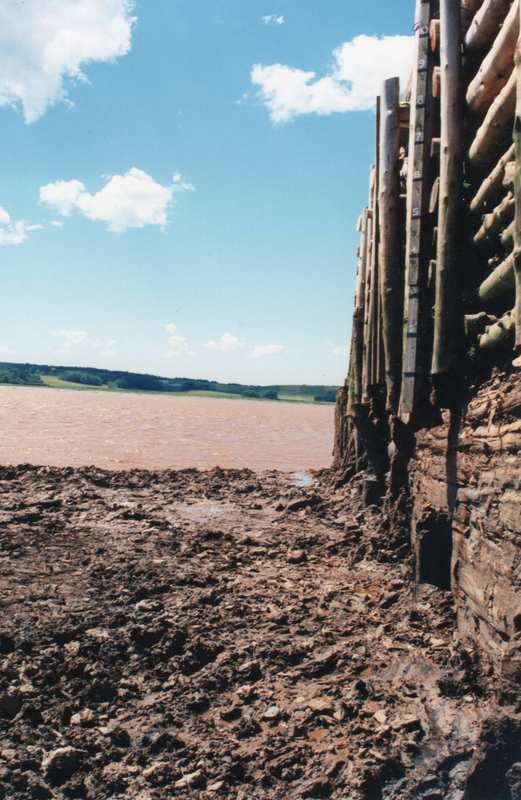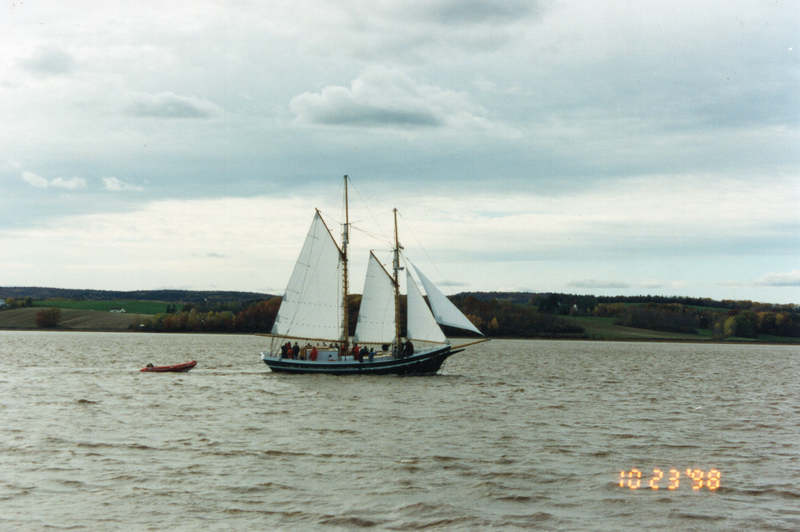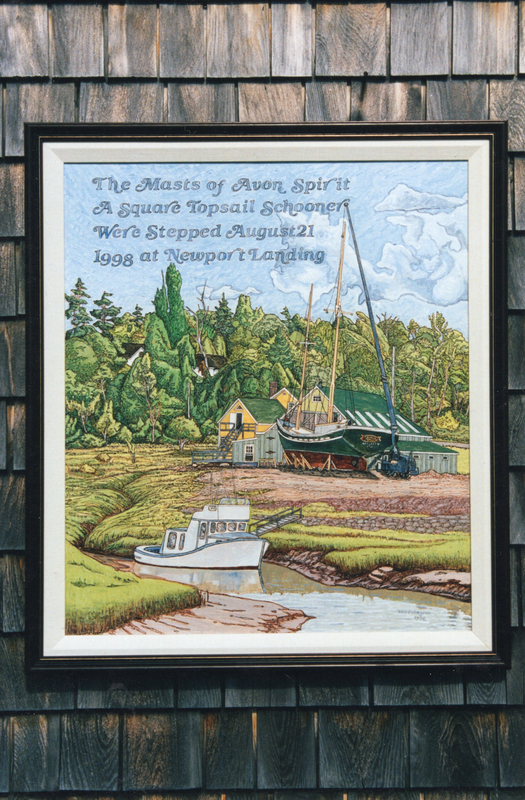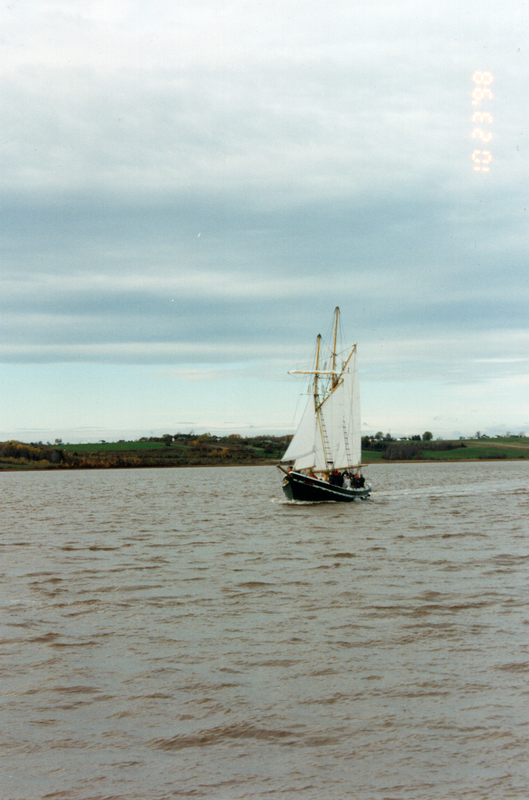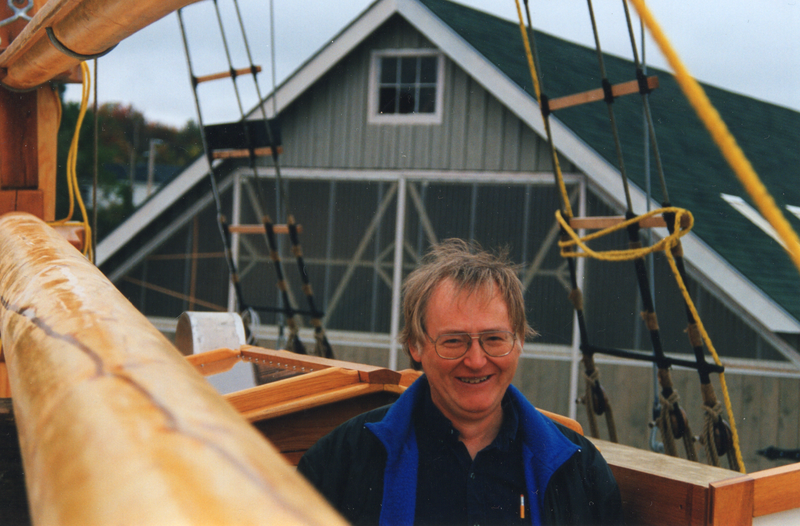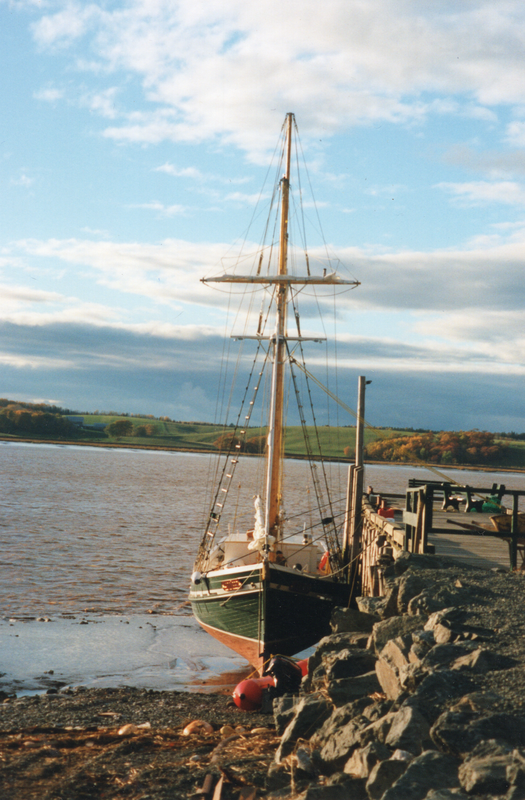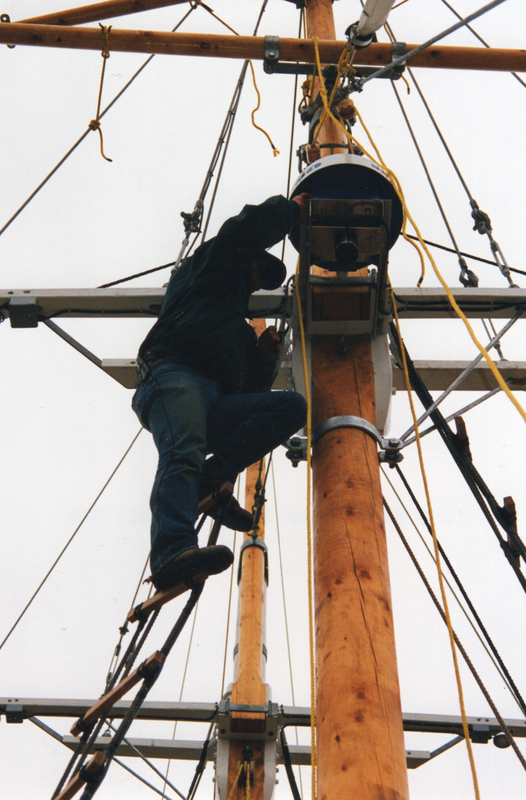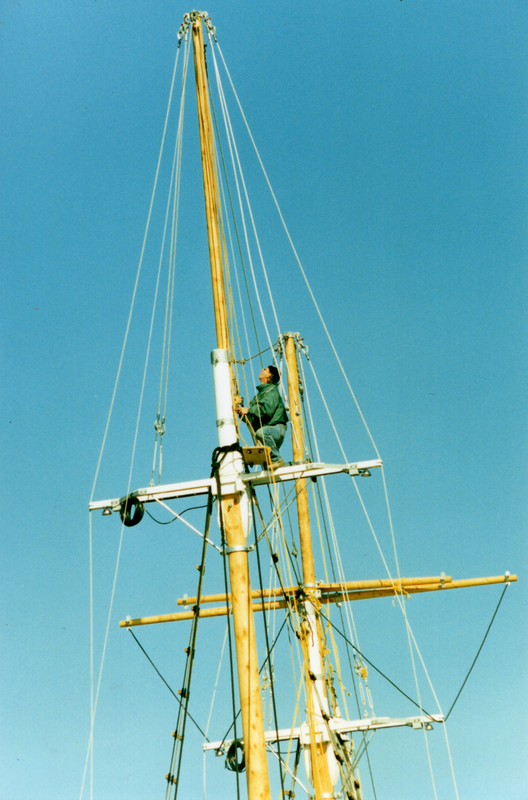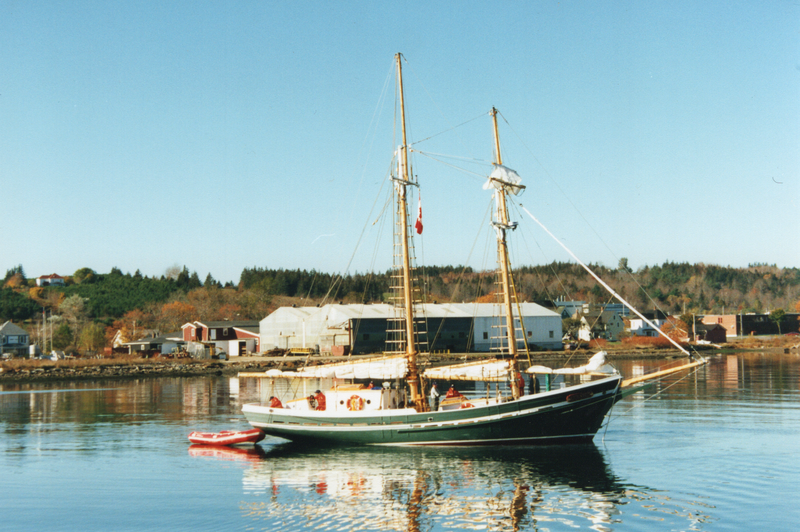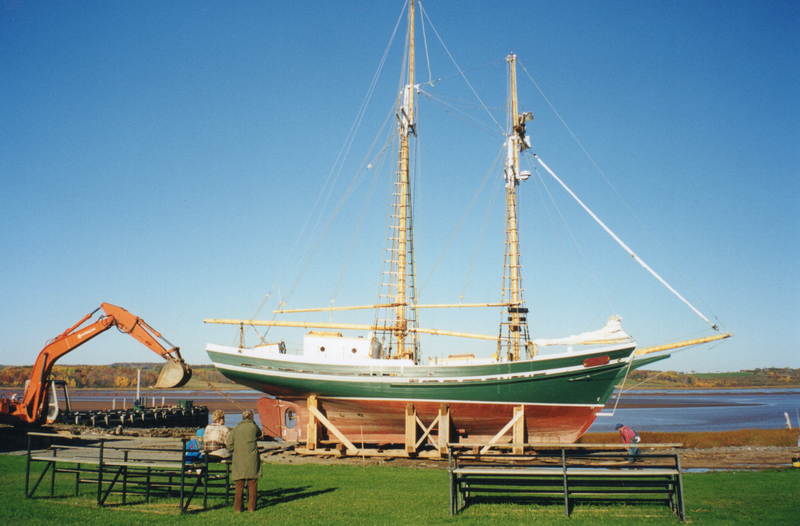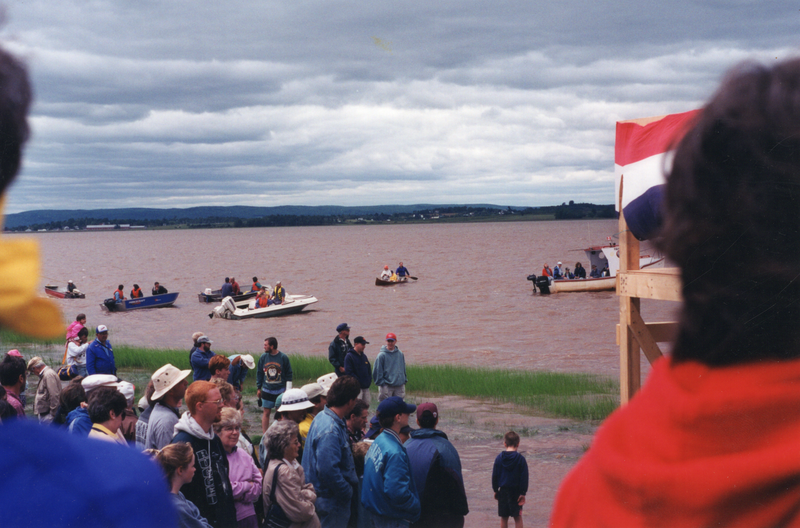The Avon Spirit
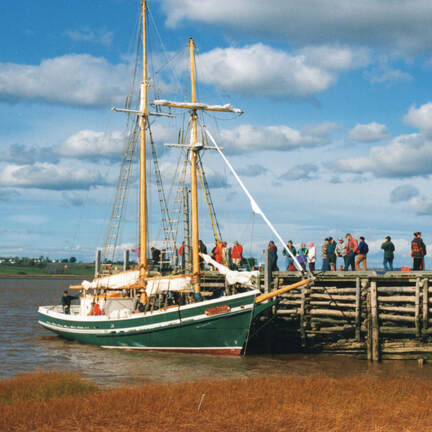
The Avon Spirit project was started in 1995 for the purpose of building a traditional wooden schooner to raise money and interest towards the ARHS and our local history as ship builders. The name of the vessel was chosen to represent the self-reliant and dynamic spirit of the planter descendants who lived during the shipbuilding period in Avondale.
The Avon Spirit was modeled after the topsail schooner F. B. G., which was built in 1929 in Kingsport to carry cargo around the Avon River. The launching of the Avon Spirit happened on July 20, 1997, almost a year after the laying of its keel. The idea was to sell the schooner after some time had passed and use the money for constructing more vessels. In order to attract buyers, the schooner sailed around Mahone Bay, Halifax, Bedford, and other areas.
Unfortunately no buyers were found and the worsening financial situation surrounding the Avon Spirit led to it being laid up in Lunenburg and later in Ingonish. During a hurricane it was badly damaged and eventually she was cut up into small pieces. Even though the schooner met an untimely fate, it nevertheless fulfilled its goals of delivering recognition to the museum and to the history of shipbuilding in Avondale.
The Avon Spirit was modeled after the topsail schooner F. B. G., which was built in 1929 in Kingsport to carry cargo around the Avon River. The launching of the Avon Spirit happened on July 20, 1997, almost a year after the laying of its keel. The idea was to sell the schooner after some time had passed and use the money for constructing more vessels. In order to attract buyers, the schooner sailed around Mahone Bay, Halifax, Bedford, and other areas.
Unfortunately no buyers were found and the worsening financial situation surrounding the Avon Spirit led to it being laid up in Lunenburg and later in Ingonish. During a hurricane it was badly damaged and eventually she was cut up into small pieces. Even though the schooner met an untimely fate, it nevertheless fulfilled its goals of delivering recognition to the museum and to the history of shipbuilding in Avondale.
How the idea was born
It all began with the rebuilding of the Avondale Wharf in 1991. On the early anniversaries of what became known as Wharf Day, many local residents brought pictures and artifacts for others to see, in what was the “museum for a day” in the basement of the Avondale United Church.
From this small beginning the Avon River Heritage Society was conceived and led in turn to the opening of the Planters Sea Chest Gift Shop and the “Lydia and Sally” Café, named for the two sloops, the Lydia and the Sally, who brought the first 13 families to Newport Landing from Newport, Rhode Island in May of 1760.
It all began with the rebuilding of the Avondale Wharf in 1991. On the early anniversaries of what became known as Wharf Day, many local residents brought pictures and artifacts for others to see, in what was the “museum for a day” in the basement of the Avondale United Church.
From this small beginning the Avon River Heritage Society was conceived and led in turn to the opening of the Planters Sea Chest Gift Shop and the “Lydia and Sally” Café, named for the two sloops, the Lydia and the Sally, who brought the first 13 families to Newport Landing from Newport, Rhode Island in May of 1760.
An early idea for the fledging museum was to erect a simple mock up or skeleton made of soft wood, designed to show how the old wooden vessels would have been constructed. The intention was to have a keel, stem, sternpost, a few frames and planking, such that the joints could be appreciated and a visitor could caulk a seam or bang in a wooden spike or treenails, used to fasten the planks to the sawn frames. Little progress was made on this project.
One day in December 1995 George Mounce the president of Avon Spirit Inc. and “Father” of Avon Spirit herself (and whose grandfather was an intrepid and most successful ship’s captain and ship owner in the last century) saw that the museum was not getting very far with this simple project, and suggested that instead of producing a static display – why not build the real thing? Why not form a small company and build a top sailschooner?
One day in December 1995 George Mounce the president of Avon Spirit Inc. and “Father” of Avon Spirit herself (and whose grandfather was an intrepid and most successful ship’s captain and ship owner in the last century) saw that the museum was not getting very far with this simple project, and suggested that instead of producing a static display – why not build the real thing? Why not form a small company and build a top sailschooner?
What Vessel to Build?
At this stage Graham McBride of the Maritime Museum of the Atlantic in Halifax, entered the picture and asked a simple question – “have you seen these?”- as he drew forth the plans of the last coastal cargo schooner built in Nova Scotia, the “FBG”.
The FBG was built by two owners in Kingsport in 1929, and for many years carried coal and other cargo to ports on the Avon River, New Minas Basin and Bay of Fundy. She was the last vessel registered on the old Windsor Registry of Shipping.
Hurricane Edna ended her days in 1954 when she was wrecked on the beach within a few yards of where she was built. The FBG looked to be the right vessel to build. She was 64 feet on deck and a ship that could ground out in the tidal waters of this area. For reasons of economy the original length was reduced by 10 feet and then her lines completely redrawn.
At this stage Graham McBride of the Maritime Museum of the Atlantic in Halifax, entered the picture and asked a simple question – “have you seen these?”- as he drew forth the plans of the last coastal cargo schooner built in Nova Scotia, the “FBG”.
The FBG was built by two owners in Kingsport in 1929, and for many years carried coal and other cargo to ports on the Avon River, New Minas Basin and Bay of Fundy. She was the last vessel registered on the old Windsor Registry of Shipping.
Hurricane Edna ended her days in 1954 when she was wrecked on the beach within a few yards of where she was built. The FBG looked to be the right vessel to build. She was 64 feet on deck and a ship that could ground out in the tidal waters of this area. For reasons of economy the original length was reduced by 10 feet and then her lines completely redrawn.
Construction of the Avon Spirit
The Laying of the Keel
A fixed price contract was signed with the Snyder’s Shipyard and work began. The same shipwrights, who had rebuilt Bluenose II and given her new life, are the men who have constructed Avon Spirit. The keel laying ceremony was held on Wharf Day, July 13, 1996. In a steady rain 250 braved the day to hear the address by the Guest of Honor, Stanley Spicer, Maritime Historian and author. In a moving moment they witnessed the insertion into the keel of an 1864 Nova Scotia penny by a family of young descendants of the Mosher Shipbuilder. A 1996 Canadian Silver dollar was also put into the keel by Mr. Gordan Knowles, the great nephew of the 19th century Master Builder in Avondale. All materials in the vessel have been produced in Nova Scotia except for the white oak for the frame which came from North Carolina.
A fixed price contract was signed with the Snyder’s Shipyard and work began. The same shipwrights, who had rebuilt Bluenose II and given her new life, are the men who have constructed Avon Spirit. The keel laying ceremony was held on Wharf Day, July 13, 1996. In a steady rain 250 braved the day to hear the address by the Guest of Honor, Stanley Spicer, Maritime Historian and author. In a moving moment they witnessed the insertion into the keel of an 1864 Nova Scotia penny by a family of young descendants of the Mosher Shipbuilder. A 1996 Canadian Silver dollar was also put into the keel by Mr. Gordan Knowles, the great nephew of the 19th century Master Builder in Avondale. All materials in the vessel have been produced in Nova Scotia except for the white oak for the frame which came from North Carolina.
The Opening of the Shipyard
The shipyard opened November 17, 1996. Avon Spirit was then “in frame” – that is all her rough sawn frames had been set in place and plumbed. Work continued throughout the winter. There was no heat in the building and an old sail from Bluenose II helped block the North wind blasting down its long fetch of the Avon River.
The shipyard opened November 17, 1996. Avon Spirit was then “in frame” – that is all her rough sawn frames had been set in place and plumbed. Work continued throughout the winter. There was no heat in the building and an old sail from Bluenose II helped block the North wind blasting down its long fetch of the Avon River.
The Construction of “Avon Spirit”
The 32 sawn white oak frames are made from 2 pieces of 3” stock bolted together with stainless steel bolts. Very wide ‘live edge’ planks were needed to allow the frames to follow the curve of the bilge. The dimension and bevels were taken from the lofting floor, made into the moulds or patterns and then the wood was cut on very large shipbuilder’s band saw that allows the articulation of the blade at intervals for adjusting to the changes in bevel. When set in place on the keel, the frames, keelson, and main keel were all bolted together. Some stakes were steamed to allow them to take up the necessary twists and bends so they could lie flat against the frames. They were spiked to the frames with about 600 pounds of galvanized steel spikes. In the seams the caulker, with great skill and considerable labour fitted first the cotton and then the oakum caulking. The seams were then painted, puttied and the outside paint applied. The hull above the waterline is painted in the same dark sea green as her forerunner, the FBG.
The 32 sawn white oak frames are made from 2 pieces of 3” stock bolted together with stainless steel bolts. Very wide ‘live edge’ planks were needed to allow the frames to follow the curve of the bilge. The dimension and bevels were taken from the lofting floor, made into the moulds or patterns and then the wood was cut on very large shipbuilder’s band saw that allows the articulation of the blade at intervals for adjusting to the changes in bevel. When set in place on the keel, the frames, keelson, and main keel were all bolted together. Some stakes were steamed to allow them to take up the necessary twists and bends so they could lie flat against the frames. They were spiked to the frames with about 600 pounds of galvanized steel spikes. In the seams the caulker, with great skill and considerable labour fitted first the cotton and then the oakum caulking. The seams were then painted, puttied and the outside paint applied. The hull above the waterline is painted in the same dark sea green as her forerunner, the FBG.
Framework of the schooner the Avon Spirit
Curved vertical frames are 6”x6” white oak. Deck beams consist of 5”x5” spruce and pine. Drilled holes in both frames and deck beams housing ¾”x 10” galvanized bolts. These counter sunk bolts were covered with a tight wooded plug to protect the metal bolts.
Curved vertical frames are 6”x6” white oak. Deck beams consist of 5”x5” spruce and pine. Drilled holes in both frames and deck beams housing ¾”x 10” galvanized bolts. These counter sunk bolts were covered with a tight wooded plug to protect the metal bolts.
Choosing the Sponsor to Christen the Ship
Women of all ages were invited to participate in an essay contest with the title – “Why I would like to christen and launch the schooner Avon Spirit”.
The essay was to be under 1000 words. Many excellent entries were received and were independently judged by a panel of three women.
Both essays expressed to the independent panel much of the spirit of this whole community and which is embodied in the "Avon Spirit" project.
On July 21st, 1997 MLA Scott Brison and Vice Admiral Hugh MacNeil presented the sponsor Patricia Parker and the runner up, Keri Knowles Fletcher, with prints of the paintings created by David MacIntosh for the Avon River Heritage Museum.
Both essays expressed to the independent panel much of the spirit of this whole community and which is embodied in the “Avon Spirit” project.
Women of all ages were invited to participate in an essay contest with the title – “Why I would like to christen and launch the schooner Avon Spirit”.
The essay was to be under 1000 words. Many excellent entries were received and were independently judged by a panel of three women.
Both essays expressed to the independent panel much of the spirit of this whole community and which is embodied in the "Avon Spirit" project.
On July 21st, 1997 MLA Scott Brison and Vice Admiral Hugh MacNeil presented the sponsor Patricia Parker and the runner up, Keri Knowles Fletcher, with prints of the paintings created by David MacIntosh for the Avon River Heritage Museum.
Both essays expressed to the independent panel much of the spirit of this whole community and which is embodied in the “Avon Spirit” project.
Why I would like to christen and launch the schooner Avon Spirit by Patricia Parker.
My maiden name was Mosher. I am a descendant of the Mosher's of Newport Landing who arrived here in 1760 in the sloop called “Lydia.” I believe that the spirit of the Avon River and the spirit that is evident in the people of its shores has brought me here.
I was born on an Air Force base in Trenton, Ontario. For 18 years I lived and moved across North America with my family, following my father who was in the Canadian Military. Every summer we came to Hants County which for us, was ‘going home’ for the holidays. My parents had both grown up in the county of Hants. It was always a time of leaving the uniformly styled homes we lived in on the base and spending for a week or two every year time in my grandparents' old, huge, white country homes, which held such mystery and fodder for my imagination. I was able to get to know my relatives, aunts, cousins, uncles and grandparents over again during that week each summer. I can say that it was a time for reestablishing who I was and where my roots had begun. There was always a sense for me that this is where I should have grown up, the rivers, both Avon and Shubenacadie, seemed more than comforting to me.
When I married a man from Dartmouth, our path would take us on the road again. This time to Alberta, where we lived for eight years. We gave birth to our two children in Calgary and moved north to Innisfail in central Alberta. Once again when time and money allowed, we traveled home to Nova Scotia to be with and keep our roots firmly established in Nova Scotia.
Our oldest child was just beginning school when we decided to move back to Nova Scotia. At this point in my life I had called nineteen different places “my home” but had not lived in any one of those places for longer than three years. I really don't have a hometown, I did not grow up with a constant group of friends. What I really wanted for my children was for them to be able to call someplace their hometown. I hoped for them to have what I felt I had missed.
In 1984 My husband accepted a job offer with The Hants Journal, a weekly newspaper in Windsor, Nova Scotia. We were both surprised at this turn of events and yet it seemed to be right somehow to pick up kids and household once again. It was, after all, to Hants County. Shortly thereafter, Glen, my husband, told me he had found the house we were looking for. When I asked him where it was situated, he said “in Shangri La!”
We have lived in that house ever since. It is actually in Avondale, a township which earlier residents had called Newport Landing. Not long after moving into my home a neighbour told me the story of the man who had built the house. George Mosher, a seafaring shipbuilding ancestor of mine! I had come home to a house which I felt instantly was truly home. It was built like a ship, solid and rich in wood, sound from the storms… maybe an occasional bit of caulking was necessary. My father's family, the Mosher's of Kempt Shore originated here with James Moser and Lydia (Allen), his wife who arrived in the ship “Lydia" from Rhode Island in May of 1760. I have spent the last 13 years living in the same home now, the childhood home of my children, the one time home of one of my ancestors.
There is a sixth sense, an inner spirit, and circumstances surrounding us that lead us to the paths we take, that led my husband and me here to this community. A sense of spirit that inhabits the friends and neighbors we have come to know here. There is certainly a shared pride in this area, the Avon River shores, that has always been evident to me.
The spirit and energy that led to the rebuilding of the old Wharf in Avondale is the same spirit that has led to the establishment of a museum of our heritage and the construction of a new shipyard in Newport Landing. It is in this spirit that I will wield that bottle of champagne to christen this schooner. “The Avon Spirit” realized!
It is what has brought me home!
Patricia Parker
My maiden name was Mosher. I am a descendant of the Mosher's of Newport Landing who arrived here in 1760 in the sloop called “Lydia.” I believe that the spirit of the Avon River and the spirit that is evident in the people of its shores has brought me here.
I was born on an Air Force base in Trenton, Ontario. For 18 years I lived and moved across North America with my family, following my father who was in the Canadian Military. Every summer we came to Hants County which for us, was ‘going home’ for the holidays. My parents had both grown up in the county of Hants. It was always a time of leaving the uniformly styled homes we lived in on the base and spending for a week or two every year time in my grandparents' old, huge, white country homes, which held such mystery and fodder for my imagination. I was able to get to know my relatives, aunts, cousins, uncles and grandparents over again during that week each summer. I can say that it was a time for reestablishing who I was and where my roots had begun. There was always a sense for me that this is where I should have grown up, the rivers, both Avon and Shubenacadie, seemed more than comforting to me.
When I married a man from Dartmouth, our path would take us on the road again. This time to Alberta, where we lived for eight years. We gave birth to our two children in Calgary and moved north to Innisfail in central Alberta. Once again when time and money allowed, we traveled home to Nova Scotia to be with and keep our roots firmly established in Nova Scotia.
Our oldest child was just beginning school when we decided to move back to Nova Scotia. At this point in my life I had called nineteen different places “my home” but had not lived in any one of those places for longer than three years. I really don't have a hometown, I did not grow up with a constant group of friends. What I really wanted for my children was for them to be able to call someplace their hometown. I hoped for them to have what I felt I had missed.
In 1984 My husband accepted a job offer with The Hants Journal, a weekly newspaper in Windsor, Nova Scotia. We were both surprised at this turn of events and yet it seemed to be right somehow to pick up kids and household once again. It was, after all, to Hants County. Shortly thereafter, Glen, my husband, told me he had found the house we were looking for. When I asked him where it was situated, he said “in Shangri La!”
We have lived in that house ever since. It is actually in Avondale, a township which earlier residents had called Newport Landing. Not long after moving into my home a neighbour told me the story of the man who had built the house. George Mosher, a seafaring shipbuilding ancestor of mine! I had come home to a house which I felt instantly was truly home. It was built like a ship, solid and rich in wood, sound from the storms… maybe an occasional bit of caulking was necessary. My father's family, the Mosher's of Kempt Shore originated here with James Moser and Lydia (Allen), his wife who arrived in the ship “Lydia" from Rhode Island in May of 1760. I have spent the last 13 years living in the same home now, the childhood home of my children, the one time home of one of my ancestors.
There is a sixth sense, an inner spirit, and circumstances surrounding us that lead us to the paths we take, that led my husband and me here to this community. A sense of spirit that inhabits the friends and neighbors we have come to know here. There is certainly a shared pride in this area, the Avon River shores, that has always been evident to me.
The spirit and energy that led to the rebuilding of the old Wharf in Avondale is the same spirit that has led to the establishment of a museum of our heritage and the construction of a new shipyard in Newport Landing. It is in this spirit that I will wield that bottle of champagne to christen this schooner. “The Avon Spirit” realized!
It is what has brought me home!
Patricia Parker
The Tall Ships
The tall ships are an organization steeped in our history. Member vessels are brought to various ports to promote sail training, education, and the history of boat building. They are docked in the Halifax harbour and are featured during public events, celebrations, and tours. The Avon Spirit was not an official tall ship but was able to be an escort to other ships during the event.
The Avon Spirit sailed among the World’s Tallest Ships during the summer of 2000. It was only the second time that the Halifax harbour hosted the World’s Tallest Ships.
The tall ships are an organization steeped in our history. Member vessels are brought to various ports to promote sail training, education, and the history of boat building. They are docked in the Halifax harbour and are featured during public events, celebrations, and tours. The Avon Spirit was not an official tall ship but was able to be an escort to other ships during the event.
The Avon Spirit sailed among the World’s Tallest Ships during the summer of 2000. It was only the second time that the Halifax harbour hosted the World’s Tallest Ships.
Alison F. MacNeil is the artist who designed the medals for the Avon Spirit in honour of the Tall Ships visiting Nova Scotia.
This is how she designed and created the medal:
The blue mold was made from the dried clay original. The raised text was achieved with alphabet soup letters! Each porcelain cast was carefully re-worked and then fired. One was chosen to be the original for the casting which were made through Rant Promotions in Halifax. The casts were made in Montreal. 36% Tin with Zinc and other metals to give a harder more brittle finish with Brass Antiques finish.
This is how she designed and created the medal:
The blue mold was made from the dried clay original. The raised text was achieved with alphabet soup letters! Each porcelain cast was carefully re-worked and then fired. One was chosen to be the original for the casting which were made through Rant Promotions in Halifax. The casts were made in Montreal. 36% Tin with Zinc and other metals to give a harder more brittle finish with Brass Antiques finish.
The Avon Spirit providing tours in Ingonish, Cape Breton, Nova Scotia
Images captured by Martin Paquin, who was visiting from Montreal on August 6th, 2006
Images captured by Martin Paquin, who was visiting from Montreal on August 6th, 2006
The Last Days of the Avon Spirit
Approximately 15 years after she first sailed out of the Avon River the Avon Spirit was docked in Ingonish, Cape Breton, where she led tours. It was here that she was badly damaged during a tropical storm. It is rumoured that a hole was punctured into the hull, letting in water. Supposedly the vessel was beyond repair so the owner had her chopped up and used as firewood. We were very sad and disappointed to hear of her fate.
Approximately 15 years after she first sailed out of the Avon River the Avon Spirit was docked in Ingonish, Cape Breton, where she led tours. It was here that she was badly damaged during a tropical storm. It is rumoured that a hole was punctured into the hull, letting in water. Supposedly the vessel was beyond repair so the owner had her chopped up and used as firewood. We were very sad and disappointed to hear of her fate.
Le projet de l’Avon Spirit a été lancé en 1995 dans le but de construire une goélette en bois traditionnelle pour récolter de l’argent et intérêt envers l’ARHS et notre histoire locale comme les constructeurs de navires. Le nom du vaisseau a été choisi pour représenter l’esprit autosuffisant et dynamique des descendants des planteurs de la Nouvelle-Angleterre qui ont vécu en Avondale pendant la période de la construction navale.
L’Avon Spirit a été modelé de la goélette à hunier F. B. G., qui fut construit en 1929 à Kingsport pour la transportation de marchandise autour de la rivière Avon. Le lancement de l’Avon Spirit s’est passé le 20 juillet 1997, presque un an après la pose de la quille. L’idée était de vendre la goélette après que quelque temps passé et utiliser l’argent pour construire plus des navires. Pour attirer les acheteurs, la goélette a navigué autour de la Baie Mahone, à Halifax, Bedford et autres domaines.
Malheureusement pas d’acheteurs ont été trouvées et l’aggravation de la situation financière qui entoure l’Avon Spirit a mené à elle étant mis à Lunenburg, puis à Ingonish. Pendant d’un ouragan, elle fut gravement endommagée et finalement elle a été découpée en petits morceaux. Même si la goélette connut un sort prématuré, elle a néanmoins rempli ses objectifs de livraison la reconnaissance au musée et à l’histoire de la construction navale à Avondale.
Comment l’idée était née
Tous ont commencé avec la reconstruction de la quai d’Avondale en 1991. Pendant les anniversaires tôt de ce qui devient connu maintenant comme « Jour de Quai », plusieurs résidents locaux ont apporté les photographies et artéfacts pour les autres de voire, dans ce qui était « musée pour un jour » dans l’Église Unie d’Avondale. Des petites commencements de l’Avon River Heritage Society était concevoir et amener à l’ouverture récente de la nouvelle boutique de cadeaux de la musée et la « Lydia et Sally » Planter salon de thé et café. Les deux sloops, « Lydia et Sally » ont apporté les premiers 13 familles à Newport Landing de Newport, Rhode Island en mai 1760. Une idée tôt pour le nouveau musée était d’ériger une maquette ou un squelette simple fait en bois tendre, conçu pour montrer comment les charpentes vieilles auraient être construit. L’intention était d’avoir une quille, la tige, un étambot, quelques charpentes et planches, alors que les charniers peuvent être appréciés et un visiteur peut calfater une couture ou cogner une pointe en bois ou treenails, utilisés pour attacher les planches aux charpentes scié. Peu de progrès était fait sur ce projet.
Un jour en décembre 1995 George Mounce le président d’Avon Spirit SARL et le « père » de l’Avon Spirit elle-même (et dont grand-père était un intrépide et brillant capitaine et propriétaire de navire dans le dernier siècle) a vu que le musée ne se faisait pas très loin avec ce projet simple, et suggéré plutôt que produisant une exposition statique – pourquoi pas construit le navire authentique? Pourquoi pas former une compagnie petite et construit un top goélette à voile.
Quelle vaisseau de construire?
À cet étape Graham McBride de la Maritime Museum of the Atlantic en Halifax, a entré la situation et a demandé une question simple – « Avez-vous voir ceux-ci? » - quand il a tiré les plans de la dernière goélette côtière de cargaison construit en la Nouvelle-Écosse, le « FBG ». le FBG était construit par deux propriétaires en Kingsport en 1929, et pour plusieurs ans a transporté le charbon et autre cargaison aux ports sur l’Avon River, New Minas Basin et le Bay of Fundy. Elle était le dernier vaisseau registré dans l’Old Windsor Registry of Shipping. L’Ouragan Edna a terminé ses jours en 1954 quand elle était complètement détruite sur une plage seulement quelques yards de où elle était construit. Le FBG regardé comme le bon vaisseau de construire. Elle était 64 pieds sur pont et un navire qui peut échouer dans les raz de marées dans cet endroit. Pour les raisons d’économie la longueur originale était réduite par 10 pieds et puis ses lignes étaient complétement redessiné.
La Pose de la Quille
Un contrat de prix fixé était signé avec le Snyder’s Shipyard et le travail a commencé. Les meme charpentiers de marines, qui avaient reconstruit Bluenose II et lui donnant une nouvelle vie, sont les hommes qui ont construit l’Avon Spirit. La cérémonie de la pose de la quille était organisée sur Wharf Day, juillet 13, 1996. Dans une pluie constante 250 ont affronté le jour pour attendre le discours de l’invité d’honneur, Stanley Spicer, historien maritime et écrivain. Dans un moment émouvant ils ont regardé l’insertion dans la quille d’un 1864 cent de la Nouvelle-Écosse par une famille des jeunes descendants du constructeur de navires Mosher. Un 1996 dollar d’argent canadien était aussi mis dans la quille par M. Gordan Knowles, le petit-neveu du 19eme siècle maçon maître en Avondale. Tous les matériaux dans le vaisseau était produit en la Nouvelle-Écosse sauf que le chêne blanc pour les charpentes qui vient de Caroline du Nord.
L’ouverture du chantier naval
Le chantier naval a ouvert le novembre 17, 1996. L’Avon Spirit était à ce moment « en charpente » - c’est tous ses charpentes rugueux scié étais mis en place et sonder. Le travail continuait pendant l’hiver. Il n’y avait aucun chaleur dans le bâtiment et un voile vielle de la Bluenose II a aidé comme blocage de les coups de ventes du nord à travers l’Avon River.
La construction de l’Avon Spirit
Les 32 charpentes de chêne blanc scié sont faites de 2 pièces de 3” stock verrouillé ensemble avec les boulons en acier inoxydable. Les planches très larges étaient nécessaires pour permettre les charpentes de suivre la courbe du fond de cale. Les dimensions et angles obliques était pris de la voilerie, faites aux les moules ou motifs et puis la bois était coupé avec un grand scie à ruban de la construction navale qui permis l’articulation de la lame aux intervalles pour l’ajustement des changements dans les angles obliques. Quand mis en place sur la quille, les charpentes, renforcement de carène, et la quille principale était tous verrouillé ensemble. Quelques poteaux étaient cuits à la vapeur pour les permettre de fait les virages nécessaires alors qu’ils pouvaient rester plats contre les charpentes. Ils étaient cloués aux charpentes avec environ 600 poids de pointes en acier galvanisé. Dans les mêmes coutures le calfat, avec des dons supers et le travail considérable a encastré premièrement le coton et puis l’étoupe. Les coutures étaient ensuite peinturées, mastiquées et le peinture d’extérieur était appliquée. La coque au-dessus la ligne de flottaison était peinturé dans la même vert glauque foncé que sa précurseur, le FBG.
La charpente de la goélette l’Avon Spirit
Les charpentes verticales incurvées sont 6”x6” chêne blanc.
Les poutres de pont consiste en 5”x5” épinette et pin.
Remarquez les trous exercés dans les deux charpentes et les poutres de pont hébergeant 3/4”x10” boulons en fer galvanisé. Ces contre coulé boulons vont être couvert avec une bonde serrée en bois pour protéger les boulons métaux.
Alison F. MacNeil est l’artiste qui a conçus les médailles pour l’Avon Spirit. Ceci c’est comment elle a conçu et créé le médaille:
Le moule bleu était fait de l’argile sèche originale. Le texte surélevé étaient fini avec les lettres de la soupe aux pâtes alphabet! Chaque moule en porcelaine était attentivement retraité puis cuit. Un était choisi pour être l’original pour la fonte qu’étaient fait par Rant Promotions en Halifax. Les moules étaient fait en Montréal. 36% étain avec le zinc et les autres métaux pour les donné une fin plus dure et cassante avec les finitions de Brass Antique.
Choisissant la Parrain pour Baptiser la Navire
Les femmes de tous âges étaient invitées de participer dans un concours de rédaction avec le titre – « Pourquoi je voudrais baptiser et mettre à l’eau la goélette Avon Spirit ». La redaction doit être moins que 1000 mots. Plusieurs candidatures excellentes étaient reçues et étaient arbitrées individuellement par un jury de trois femmes. La femme (notre parrain) est Patricia Parker et le second, Keri Knowles Fletcher.
Les deux rédactions ont exprimé au jury indépendant beaucoup de l’esprit de ce communauté entier qui est incarné dans le projet de l’Avon Spirit.
Les Tall Ships
Les Tall Ships est une organisation trempée dans notre histoire. Les membres vaisseaux sont apportés aux plusieurs ports pour la promotion du entrainement de voile, éducation, et l’histoire de la construction navale. Ils sont se mis à quai dans l’Halifax Harbour et sont présentés pendant les évènements publiques, les célébrations, et les tours. L’Avon Spirit n’était pas un Tall Ship officielle mais était capable d’être un escorte aux autres navires pendant l’évènement.
L’Avon Spirit a navigué parmi les World’s Tallest Ships pendant l’été de 2000. C’était seulement le deuxième fois que l’Halifax Harbour a reçu les World’s Tallest Ships.
Les derniers jours de l’Avon Spirit
Environ 15 ans après qu’elle a parti à voile hors de la Rivière Avon pour la première fois, l’Avon Spirit était à quai en Ingonish, Cap-Breton, où elle a guidé les visites. C’était ici où elle était gravement endommagé pendant un tempête tropicale. C’est supposé qu’un trou était crevé dans la coque, laissant entrer l’eau. Soi-disant le vaisseau n’était pas réparable alors le propriétaire lui avait coupé et utilisé comme le bois de chauffage. Nous étions très tristes et déçus d’apprendre de son sort.
Un contrat de prix fixé était signé avec le Snyder’s Shipyard et le travail a commencé. Les meme charpentiers de marines, qui avaient reconstruit Bluenose II et lui donnant une nouvelle vie, sont les hommes qui ont construit l’Avon Spirit. La cérémonie de la pose de la quille était organisée sur Wharf Day, juillet 13, 1996. Dans une pluie constante 250 ont affronté le jour pour attendre le discours de l’invité d’honneur, Stanley Spicer, historien maritime et écrivain. Dans un moment émouvant ils ont regardé l’insertion dans la quille d’un 1864 cent de la Nouvelle-Écosse par une famille des jeunes descendants du constructeur de navires Mosher. Un 1996 dollar d’argent canadien était aussi mis dans la quille par M. Gordan Knowles, le petit-neveu du 19eme siècle maçon maître en Avondale. Tous les matériaux dans le vaisseau était produit en la Nouvelle-Écosse sauf que le chêne blanc pour les charpentes qui vient de Caroline du Nord.
L’ouverture du chantier naval
Le chantier naval a ouvert le novembre 17, 1996. L’Avon Spirit était à ce moment « en charpente » - c’est tous ses charpentes rugueux scié étais mis en place et sonder. Le travail continuait pendant l’hiver. Il n’y avait aucun chaleur dans le bâtiment et un voile vielle de la Bluenose II a aidé comme blocage de les coups de ventes du nord à travers l’Avon River.
La construction de l’Avon Spirit
Les 32 charpentes de chêne blanc scié sont faites de 2 pièces de 3” stock verrouillé ensemble avec les boulons en acier inoxydable. Les planches très larges étaient nécessaires pour permettre les charpentes de suivre la courbe du fond de cale. Les dimensions et angles obliques était pris de la voilerie, faites aux les moules ou motifs et puis la bois était coupé avec un grand scie à ruban de la construction navale qui permis l’articulation de la lame aux intervalles pour l’ajustement des changements dans les angles obliques. Quand mis en place sur la quille, les charpentes, renforcement de carène, et la quille principale était tous verrouillé ensemble. Quelques poteaux étaient cuits à la vapeur pour les permettre de fait les virages nécessaires alors qu’ils pouvaient rester plats contre les charpentes. Ils étaient cloués aux charpentes avec environ 600 poids de pointes en acier galvanisé. Dans les mêmes coutures le calfat, avec des dons supers et le travail considérable a encastré premièrement le coton et puis l’étoupe. Les coutures étaient ensuite peinturées, mastiquées et le peinture d’extérieur était appliquée. La coque au-dessus la ligne de flottaison était peinturé dans la même vert glauque foncé que sa précurseur, le FBG.
La charpente de la goélette l’Avon Spirit
Les charpentes verticales incurvées sont 6”x6” chêne blanc.
Les poutres de pont consiste en 5”x5” épinette et pin.
Remarquez les trous exercés dans les deux charpentes et les poutres de pont hébergeant 3/4”x10” boulons en fer galvanisé. Ces contre coulé boulons vont être couvert avec une bonde serrée en bois pour protéger les boulons métaux.
Alison F. MacNeil est l’artiste qui a conçus les médailles pour l’Avon Spirit. Ceci c’est comment elle a conçu et créé le médaille:
Le moule bleu était fait de l’argile sèche originale. Le texte surélevé étaient fini avec les lettres de la soupe aux pâtes alphabet! Chaque moule en porcelaine était attentivement retraité puis cuit. Un était choisi pour être l’original pour la fonte qu’étaient fait par Rant Promotions en Halifax. Les moules étaient fait en Montréal. 36% étain avec le zinc et les autres métaux pour les donné une fin plus dure et cassante avec les finitions de Brass Antique.
Choisissant la Parrain pour Baptiser la Navire
Les femmes de tous âges étaient invitées de participer dans un concours de rédaction avec le titre – « Pourquoi je voudrais baptiser et mettre à l’eau la goélette Avon Spirit ». La redaction doit être moins que 1000 mots. Plusieurs candidatures excellentes étaient reçues et étaient arbitrées individuellement par un jury de trois femmes. La femme (notre parrain) est Patricia Parker et le second, Keri Knowles Fletcher.
Les deux rédactions ont exprimé au jury indépendant beaucoup de l’esprit de ce communauté entier qui est incarné dans le projet de l’Avon Spirit.
Les Tall Ships
Les Tall Ships est une organisation trempée dans notre histoire. Les membres vaisseaux sont apportés aux plusieurs ports pour la promotion du entrainement de voile, éducation, et l’histoire de la construction navale. Ils sont se mis à quai dans l’Halifax Harbour et sont présentés pendant les évènements publiques, les célébrations, et les tours. L’Avon Spirit n’était pas un Tall Ship officielle mais était capable d’être un escorte aux autres navires pendant l’évènement.
L’Avon Spirit a navigué parmi les World’s Tallest Ships pendant l’été de 2000. C’était seulement le deuxième fois que l’Halifax Harbour a reçu les World’s Tallest Ships.
Les derniers jours de l’Avon Spirit
Environ 15 ans après qu’elle a parti à voile hors de la Rivière Avon pour la première fois, l’Avon Spirit était à quai en Ingonish, Cap-Breton, où elle a guidé les visites. C’était ici où elle était gravement endommagé pendant un tempête tropicale. C’est supposé qu’un trou était crevé dans la coque, laissant entrer l’eau. Soi-disant le vaisseau n’était pas réparable alors le propriétaire lui avait coupé et utilisé comme le bois de chauffage. Nous étions très tristes et déçus d’apprendre de son sort.
